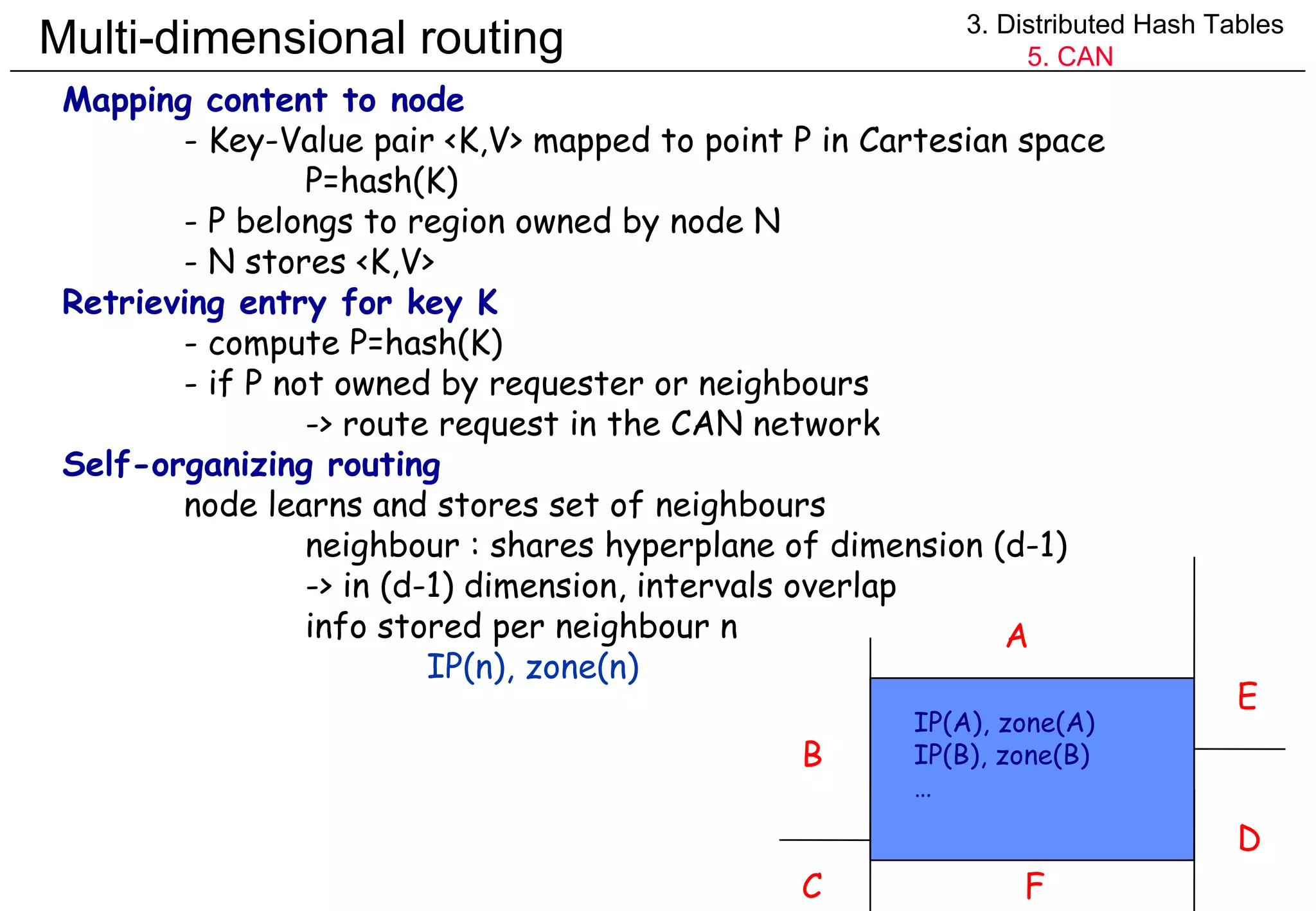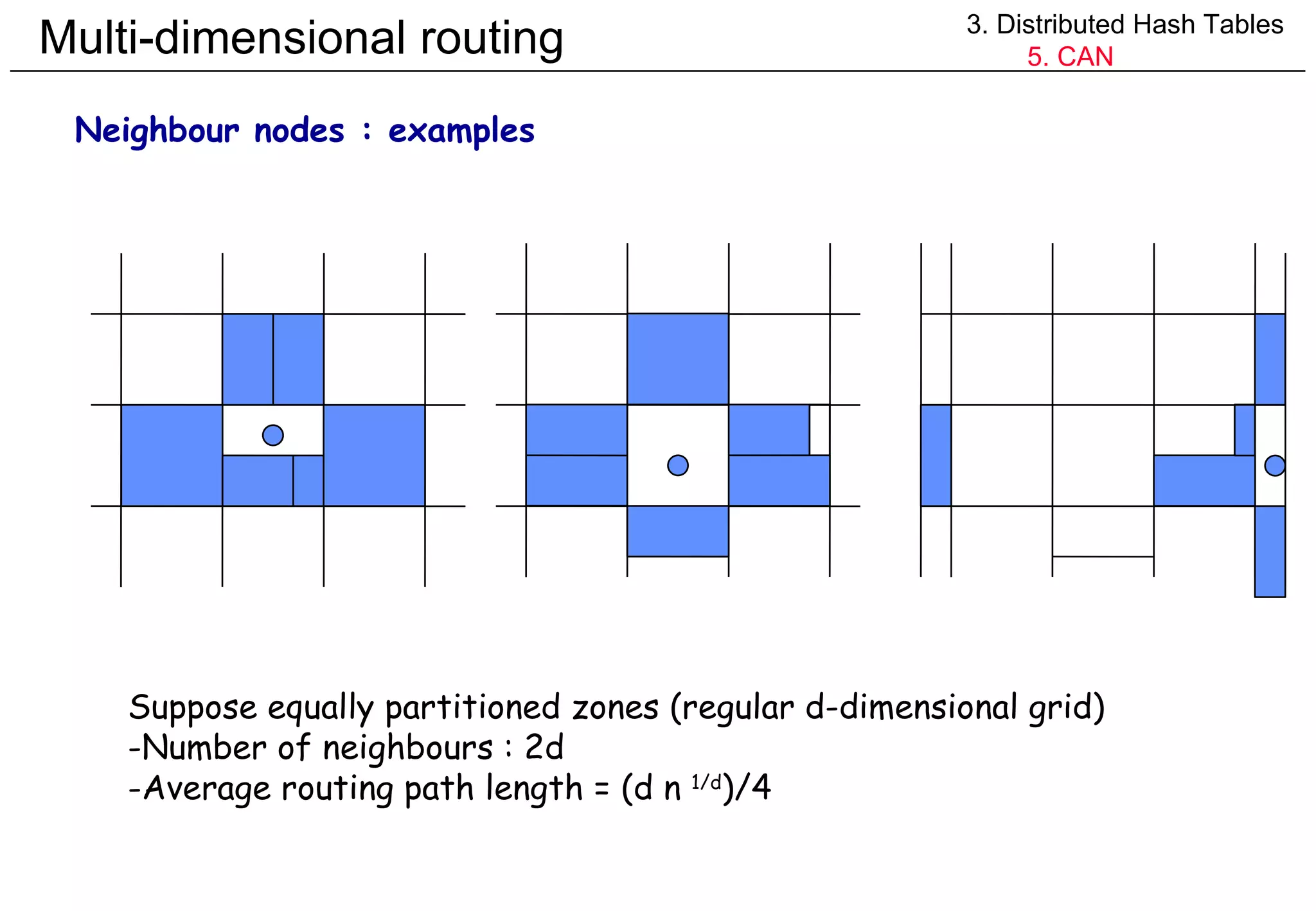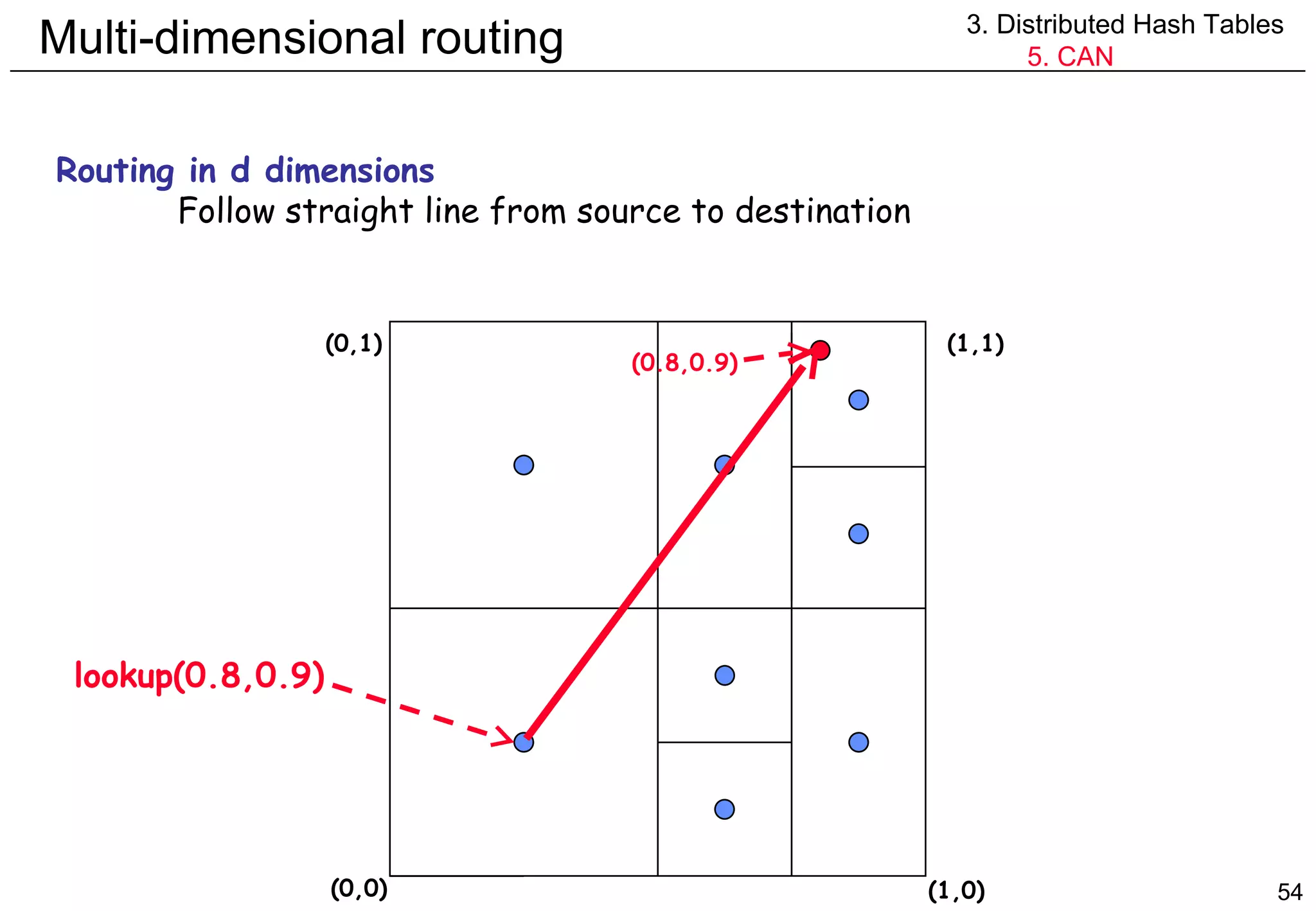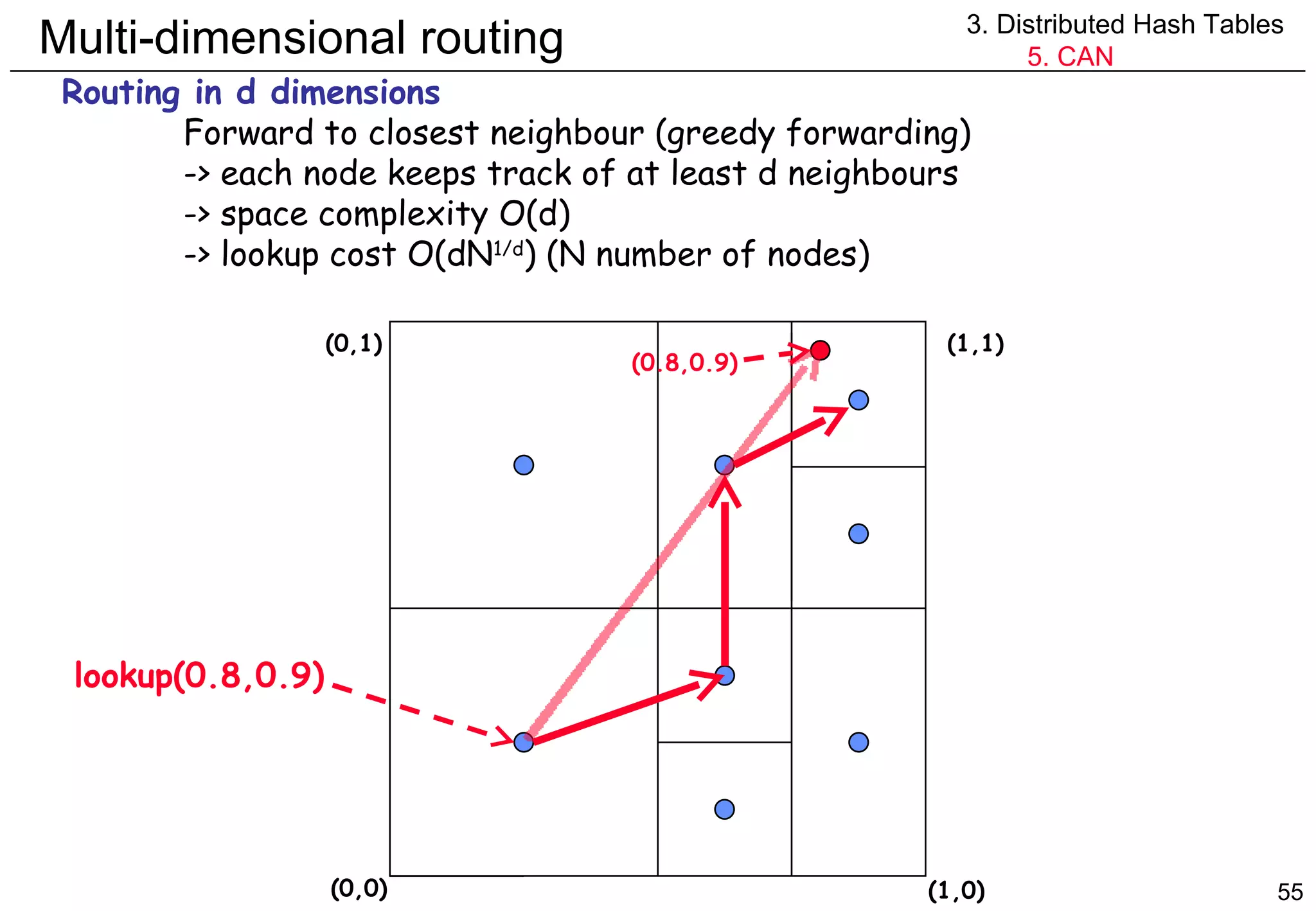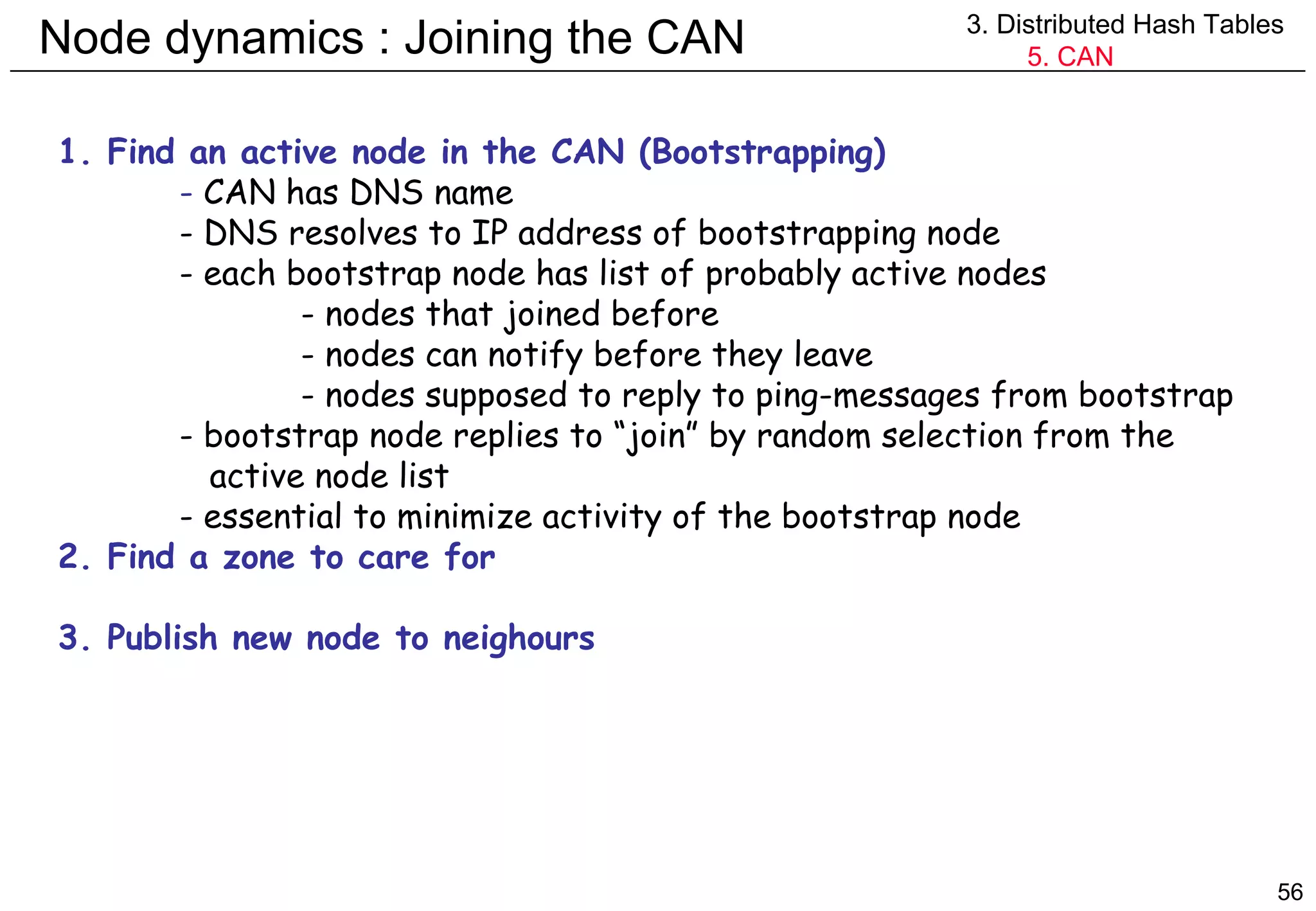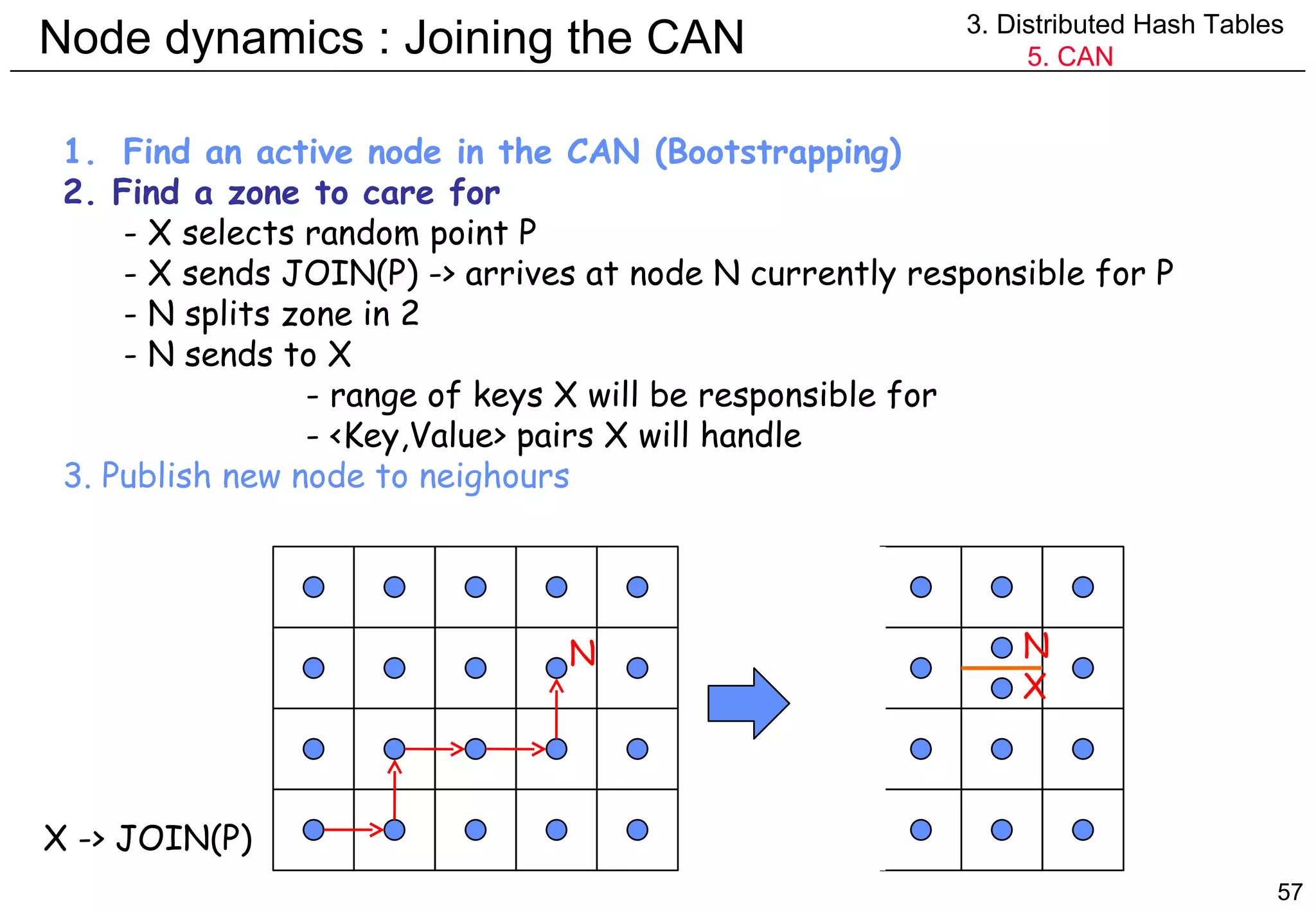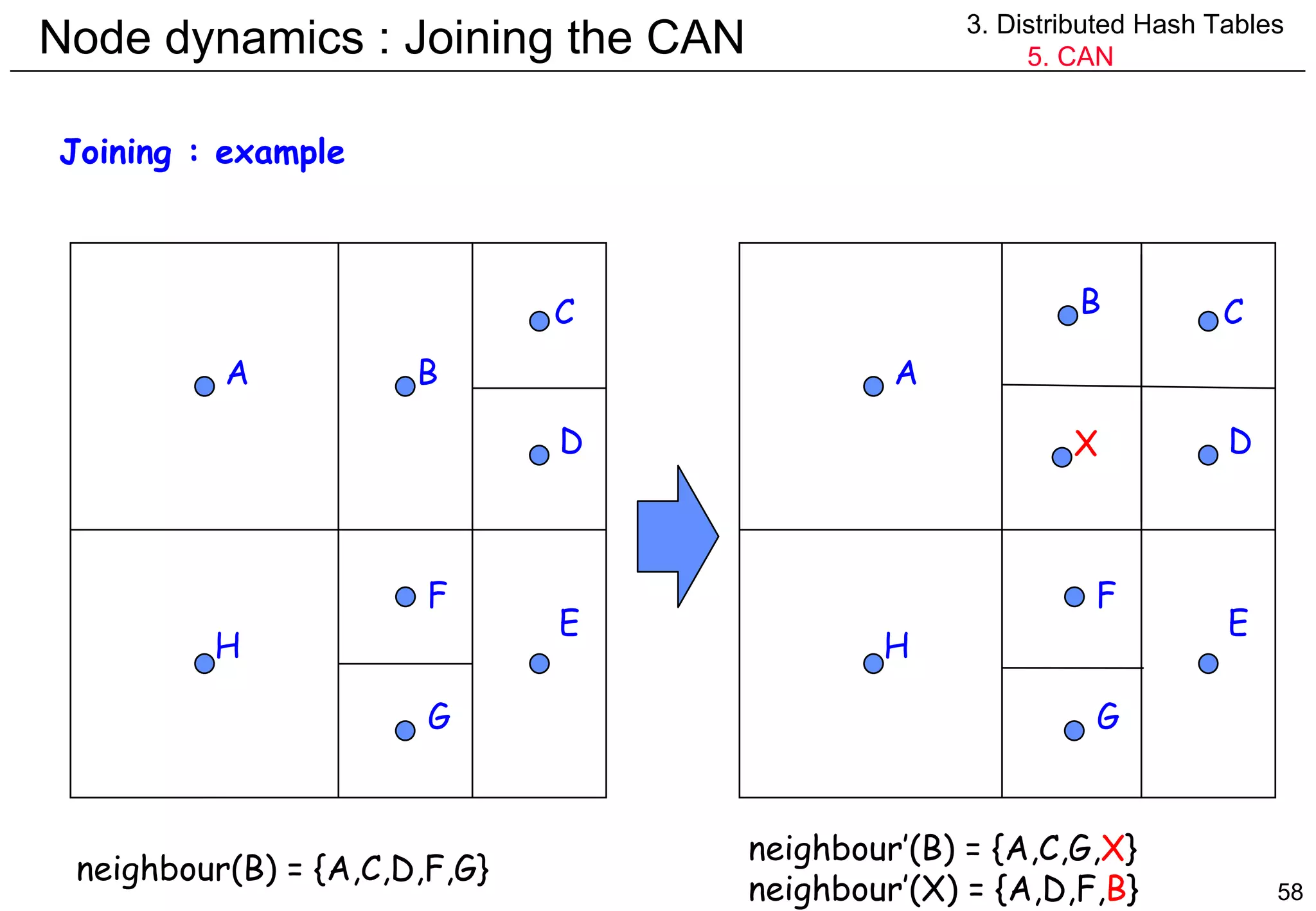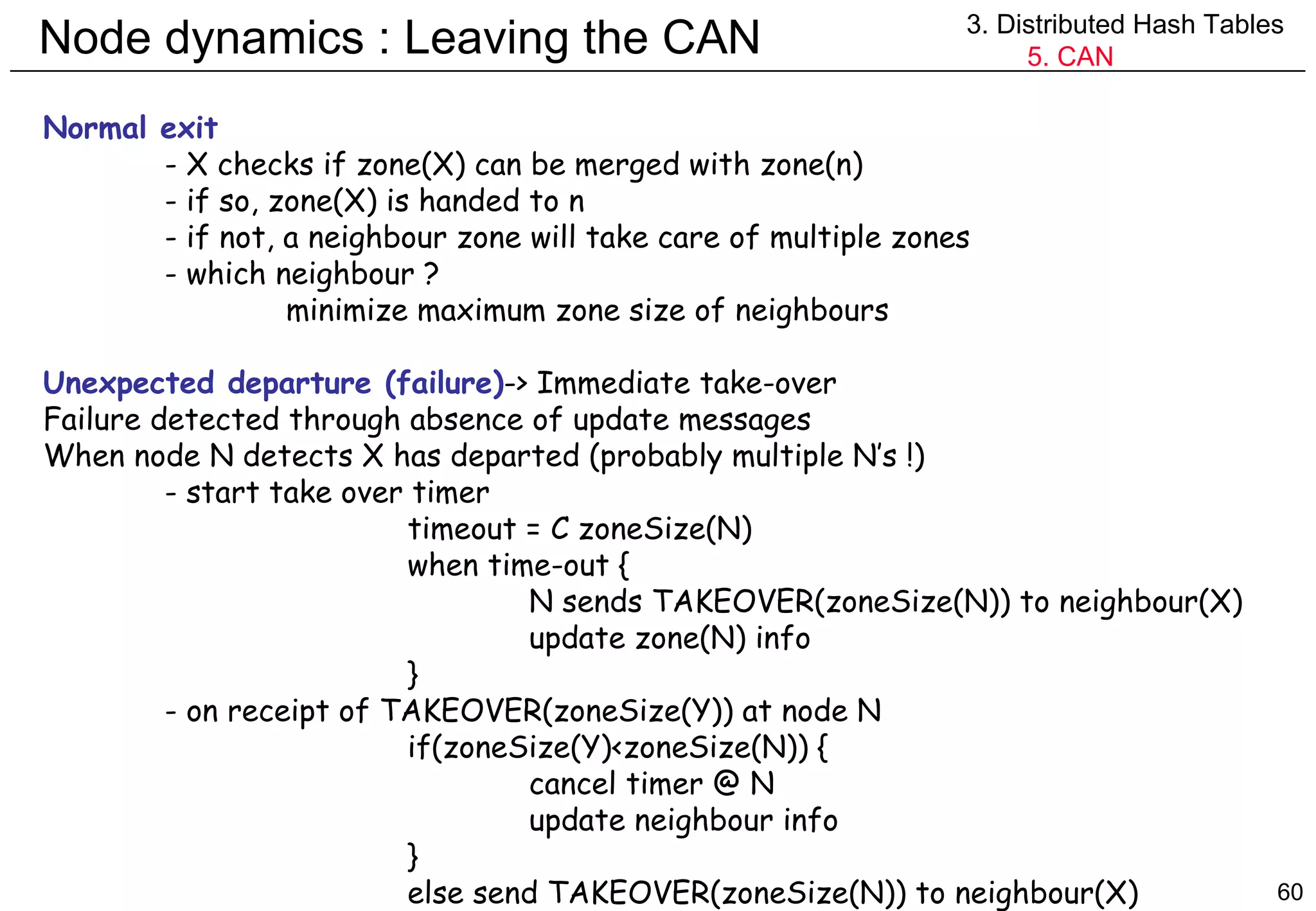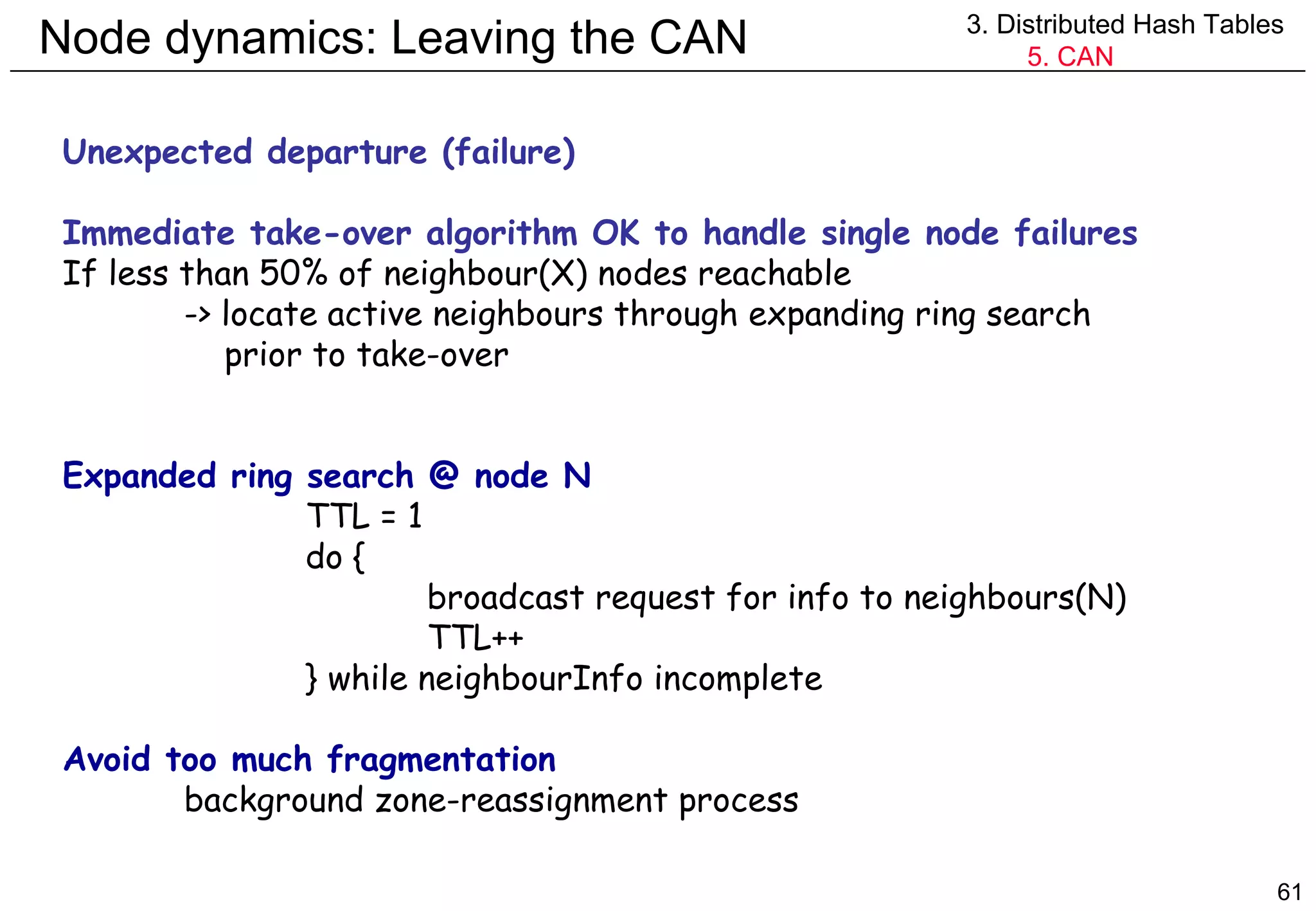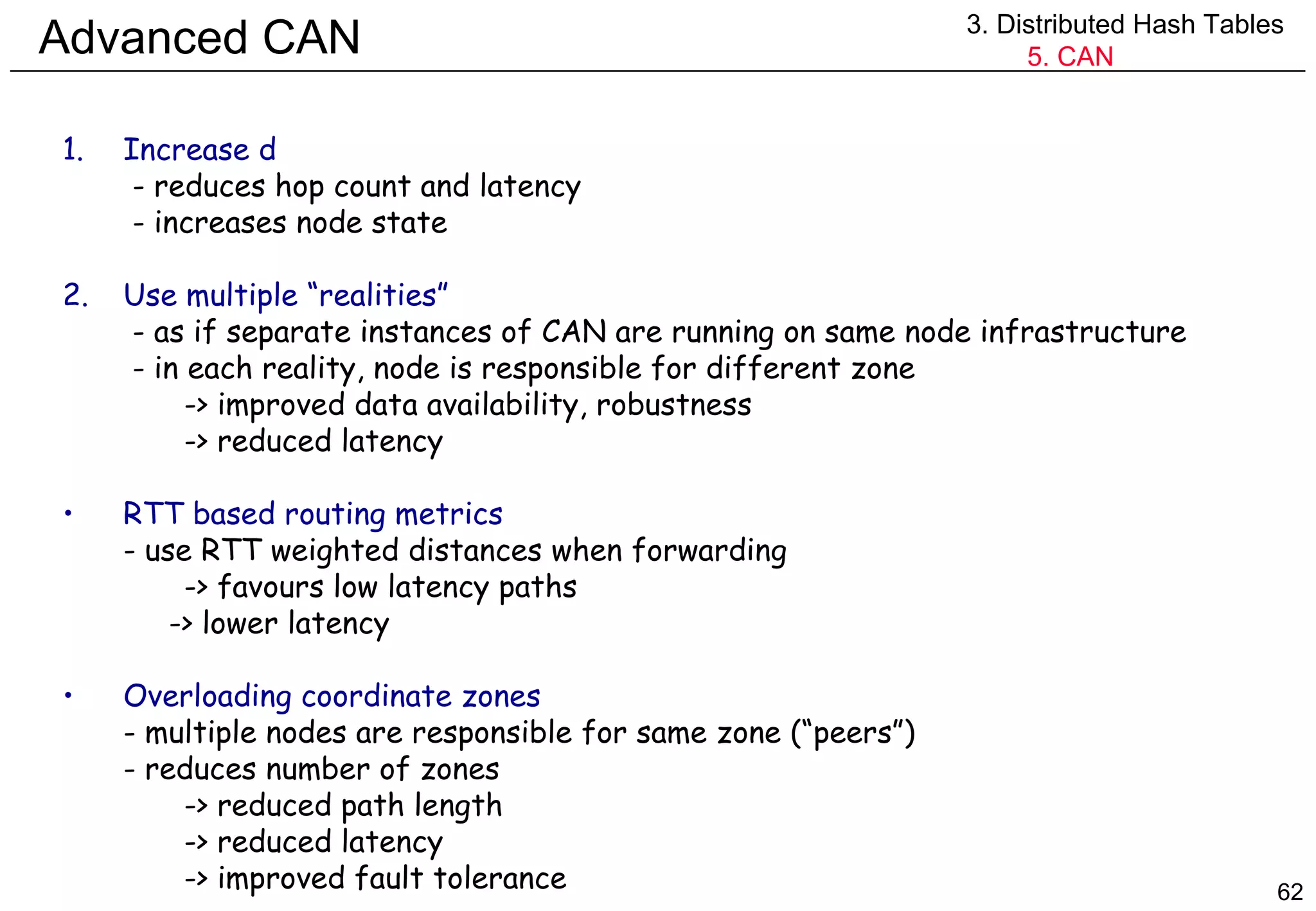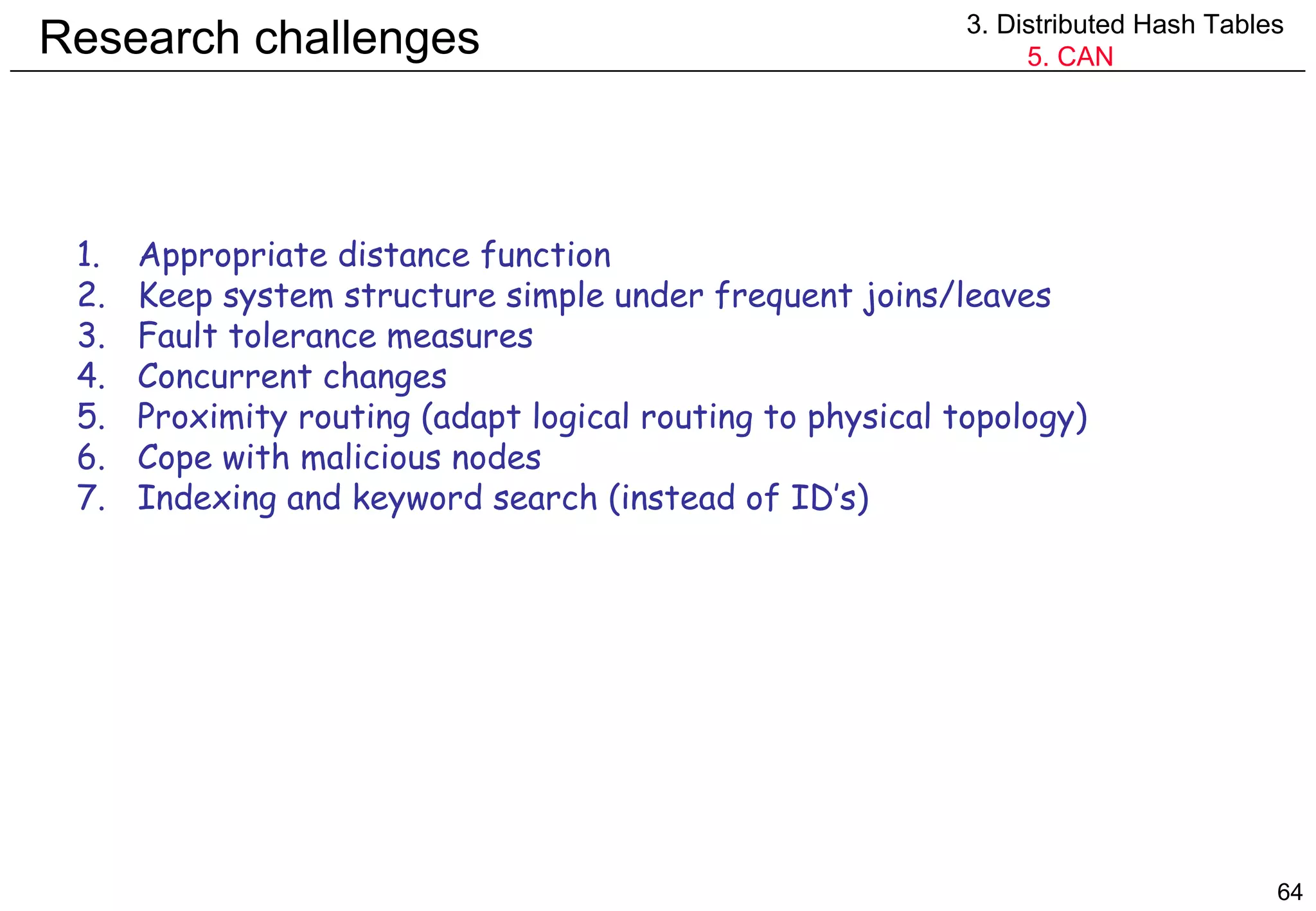This document discusses peer-to-peer (P2P) systems. It introduces the rationale for P2P, which is to leverage edge resources and scale without centralized servers. It describes three generations of P2P systems: centralized file sharing (Gen I), decentralized file sharing (Gen II), and P2P middleware (Gen III). It then discusses various P2P architectures like pure, hybrid, and mediated P2P. The rest of the document focuses on distributed hash tables (DHTs), covering concepts like GUID routing, content routing, bootstrapping, and specific DHT implementations like Pastry and Chord.
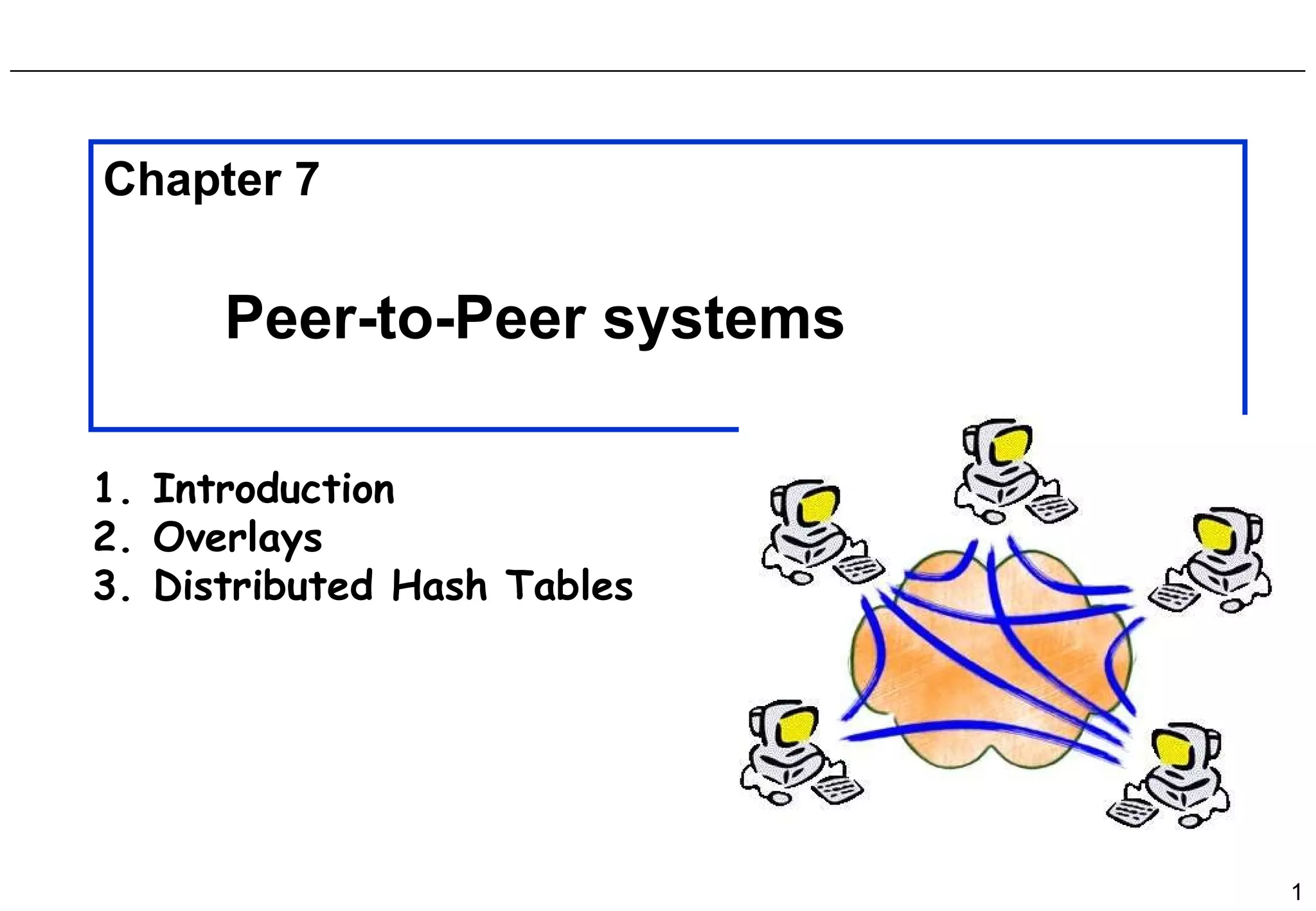
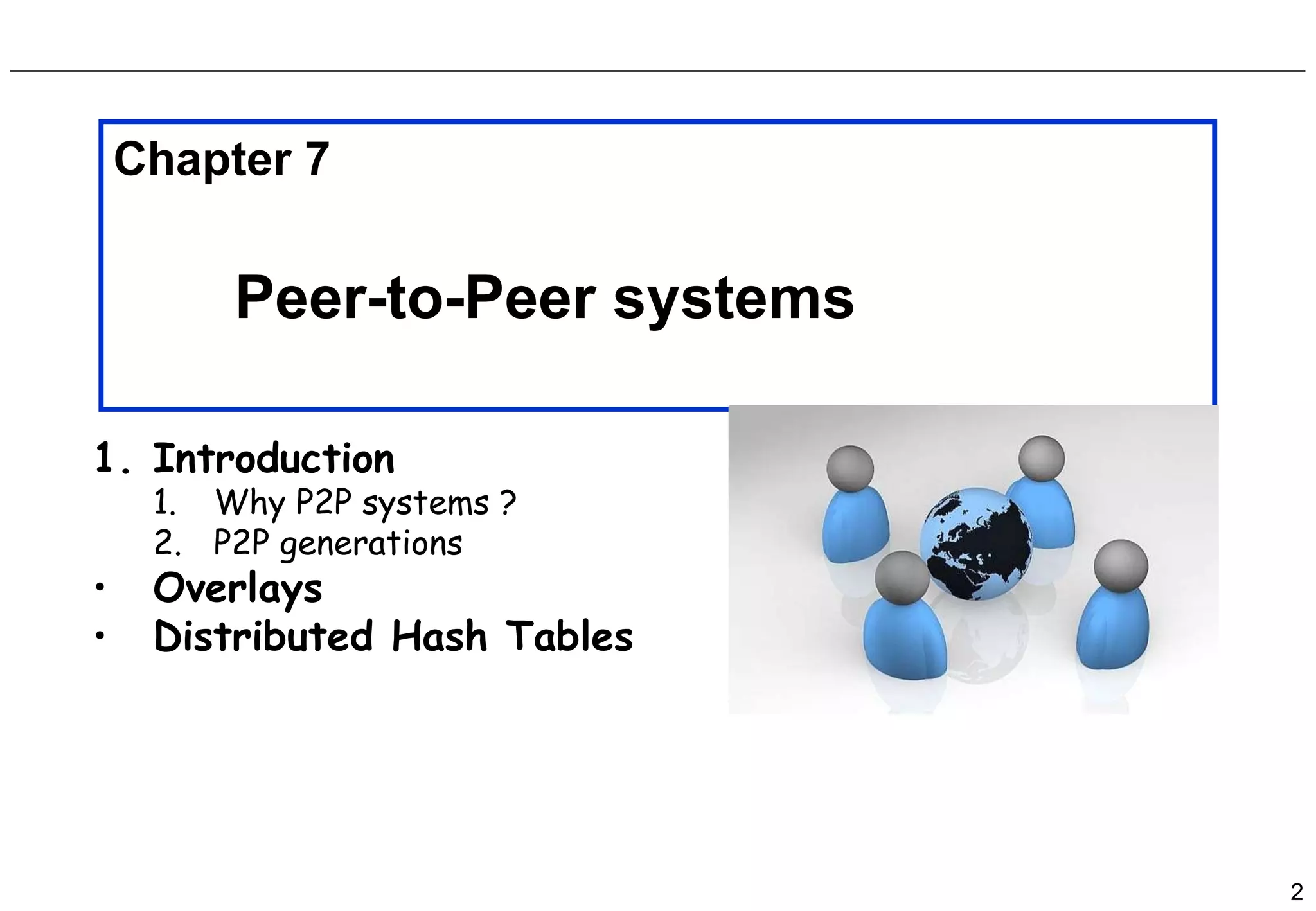

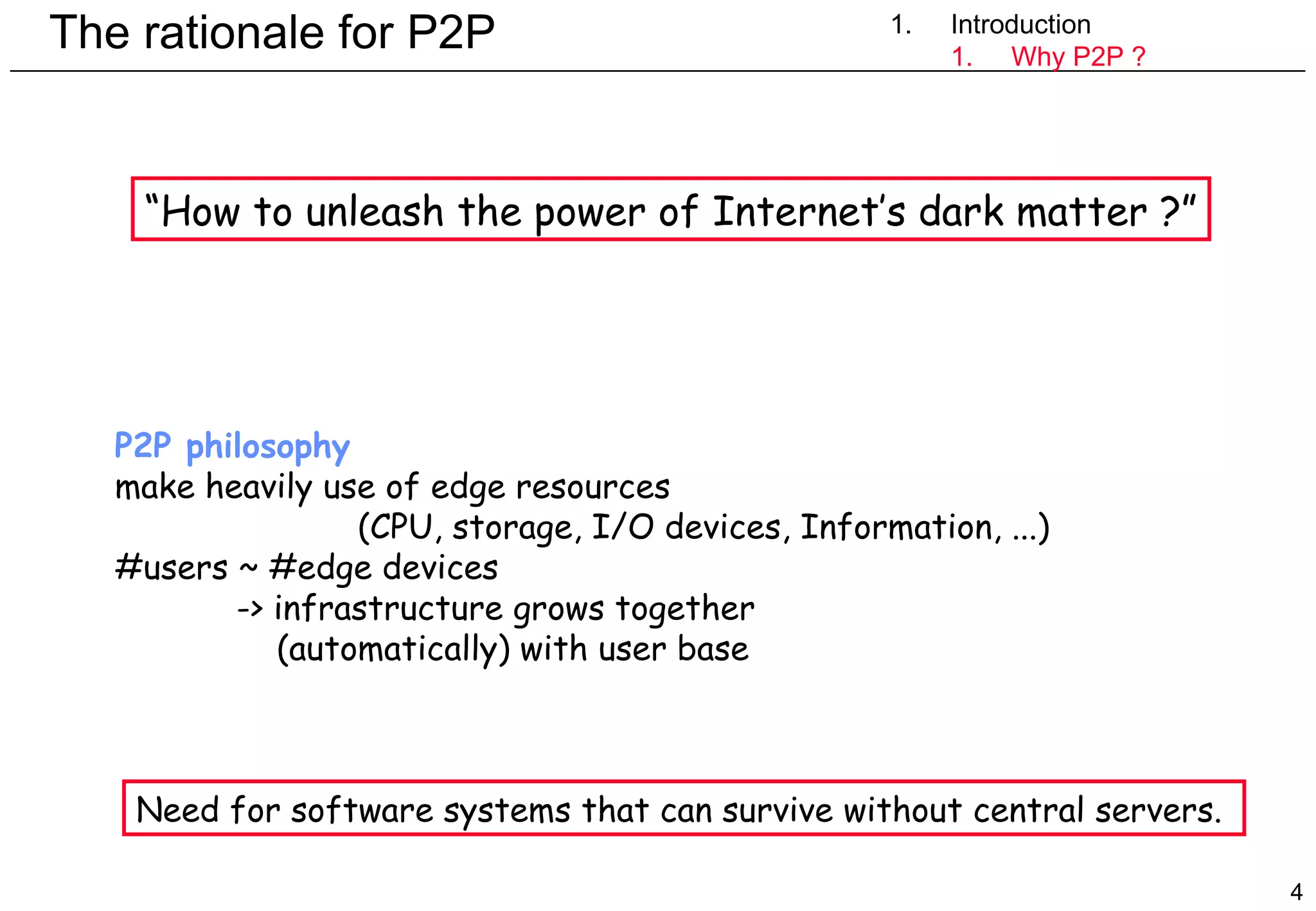
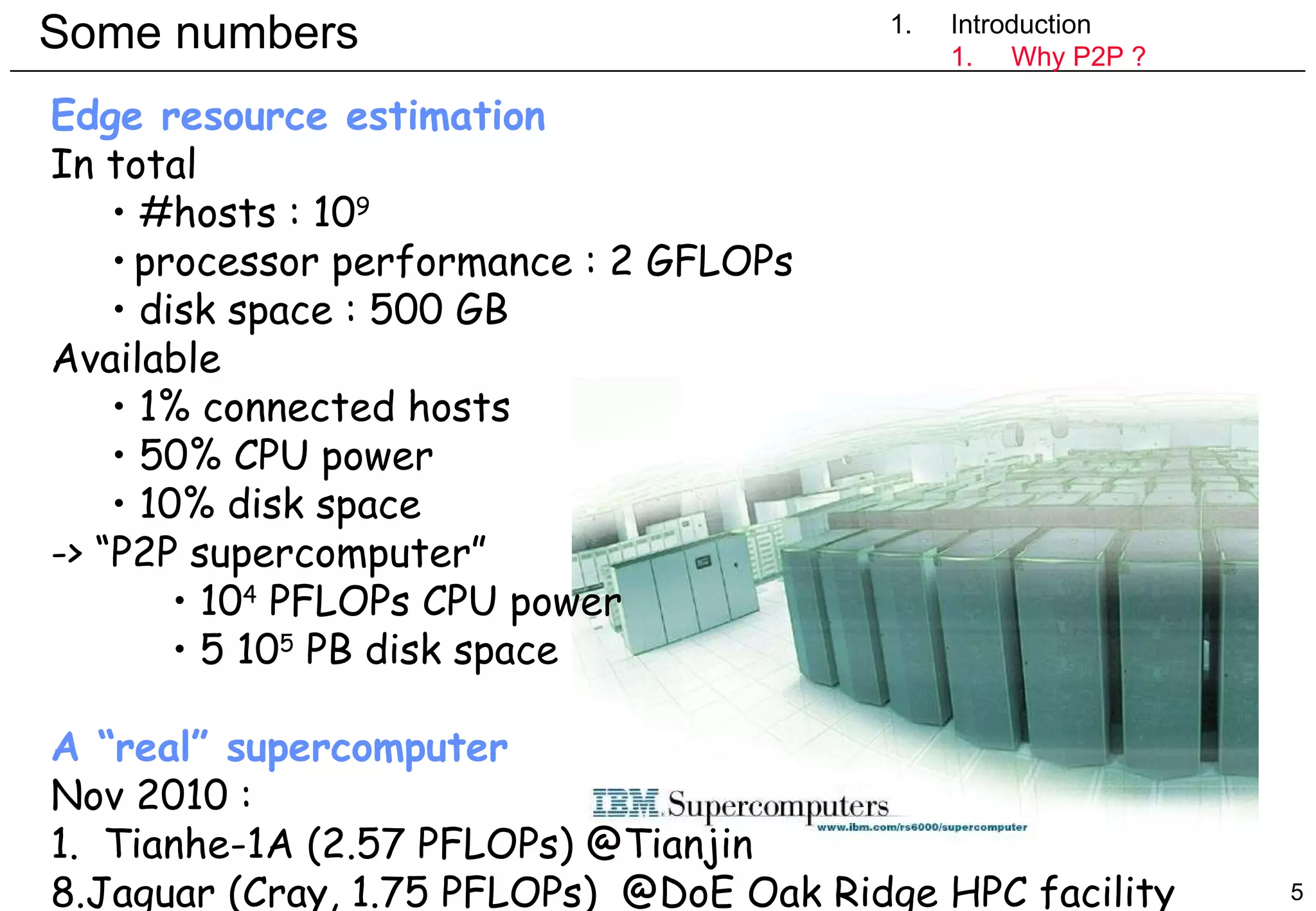
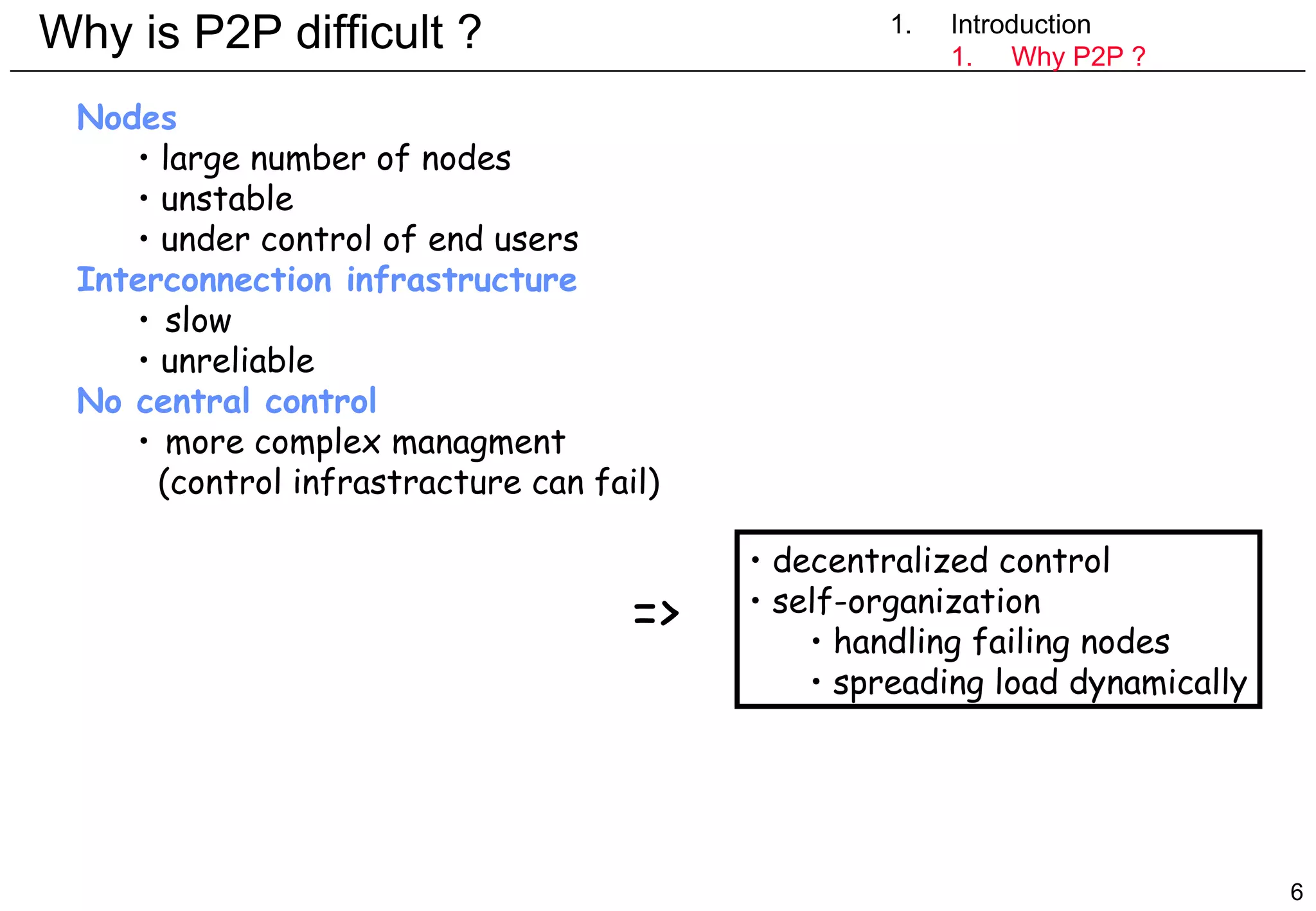
![Characteristics of P2P systems 1. Introduction Introduction Why P2P ? Shared characteristics Users contribute to the total pool of available resources (avoid free-riding) All nodes in principle equal System operation independent of centralized control Application areas file sharing collaboration tools (Groove) communication (VoIP P2P [Skype], chatting [Jabber]) CPU scavenging (SETI@Home, Folding@Home, ...) Important problems data placement and lookup routing (use the network bandwidth efficiently) provide anonimity self-organization (self-management)](https://image.slidesharecdn.com/odschapter7-120122161552-phpapp02/75/Ods-chapter7-7-2048.jpg)

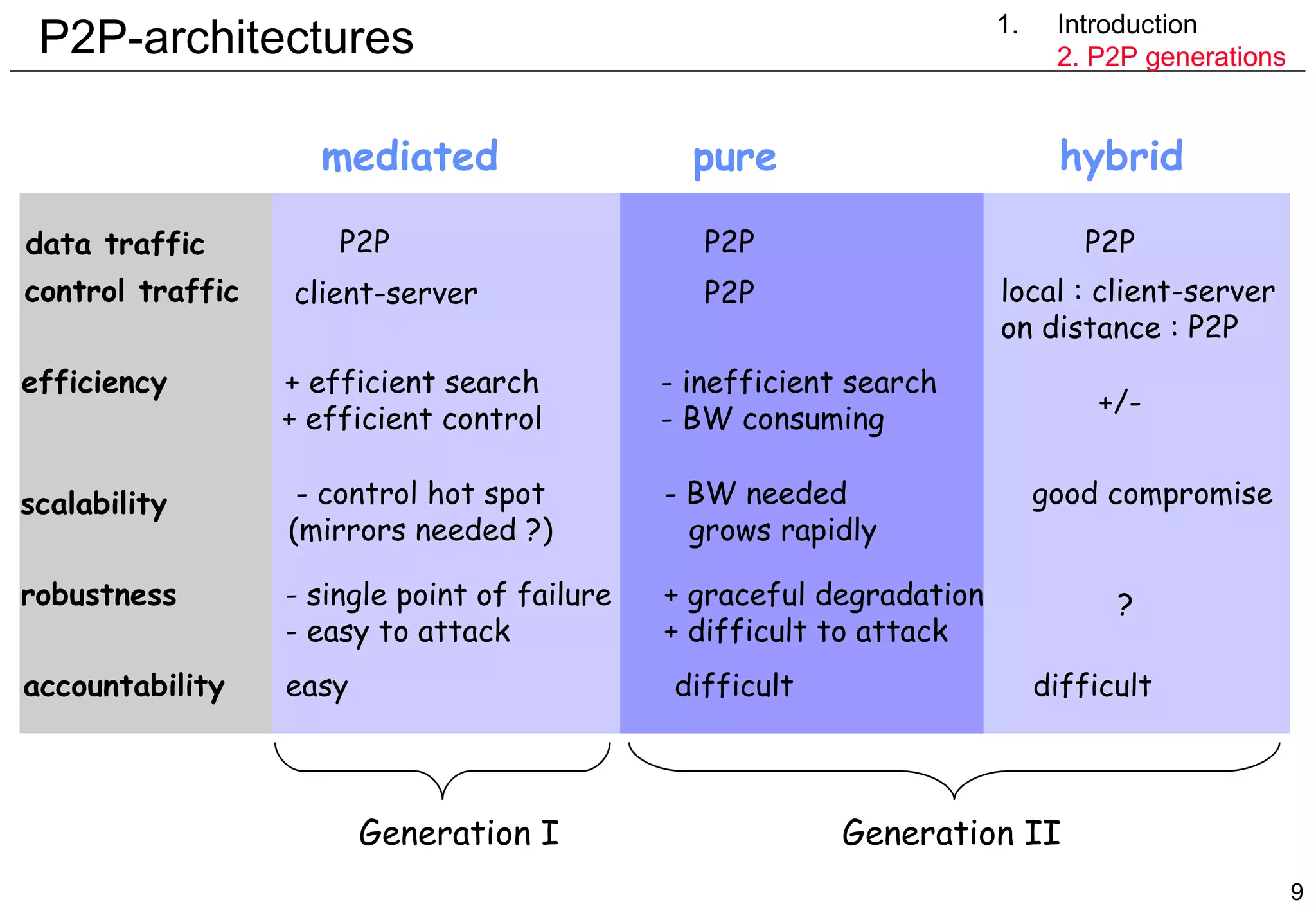

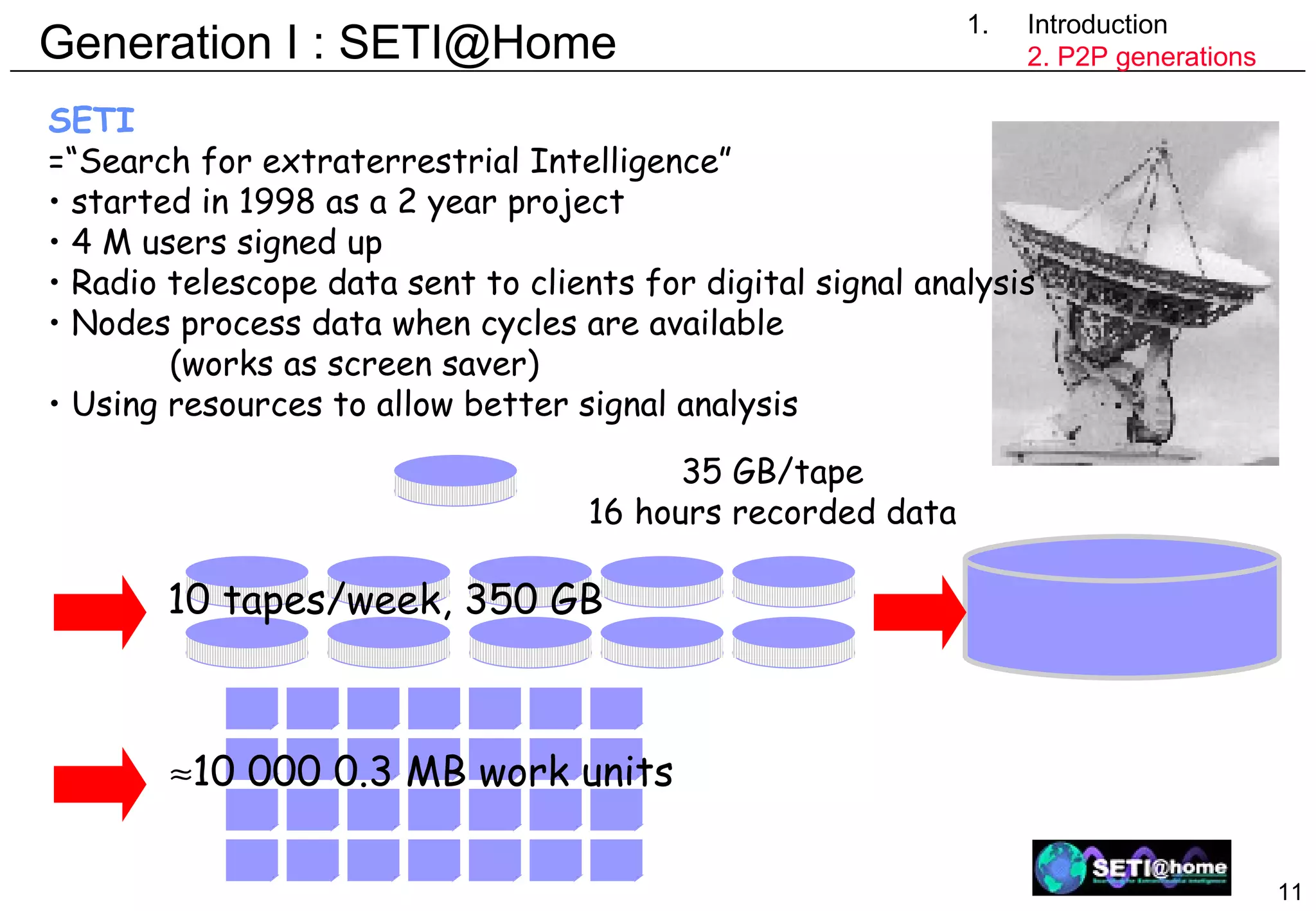
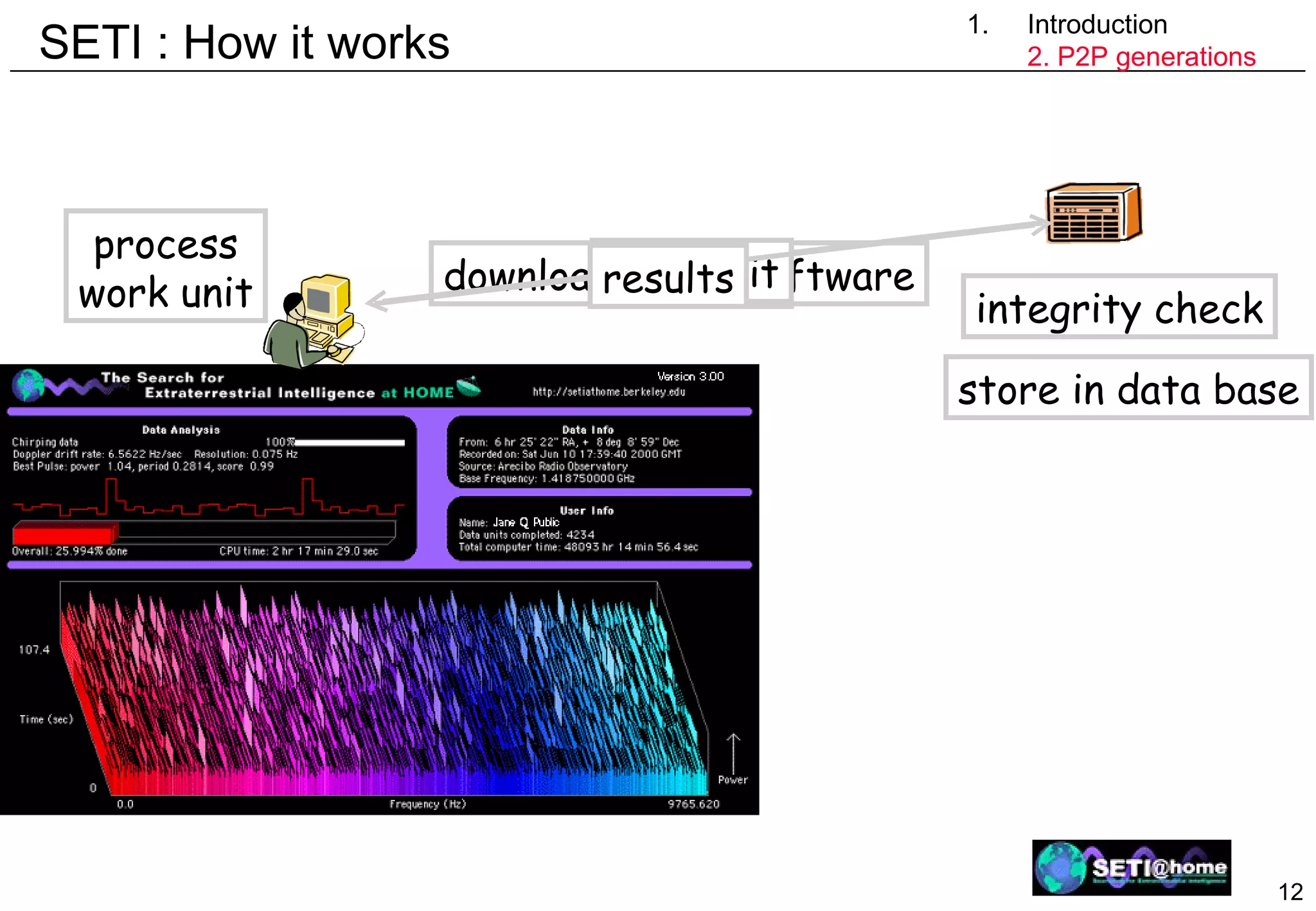
![SETI : Some numbers computations per work unit 3.1x10 12 FP-operations work unit throughput 700 000/day Introduction 2. P2P generations 22x10 17 FLOP/day >25 TFLOPS ASCI White@DoE [email_address] Processing 25 TFLOPS 12.3 TFLOPS Cost 1 M USD 110 M USD](https://image.slidesharecdn.com/odschapter7-120122161552-phpapp02/75/Ods-chapter7-13-2048.jpg)
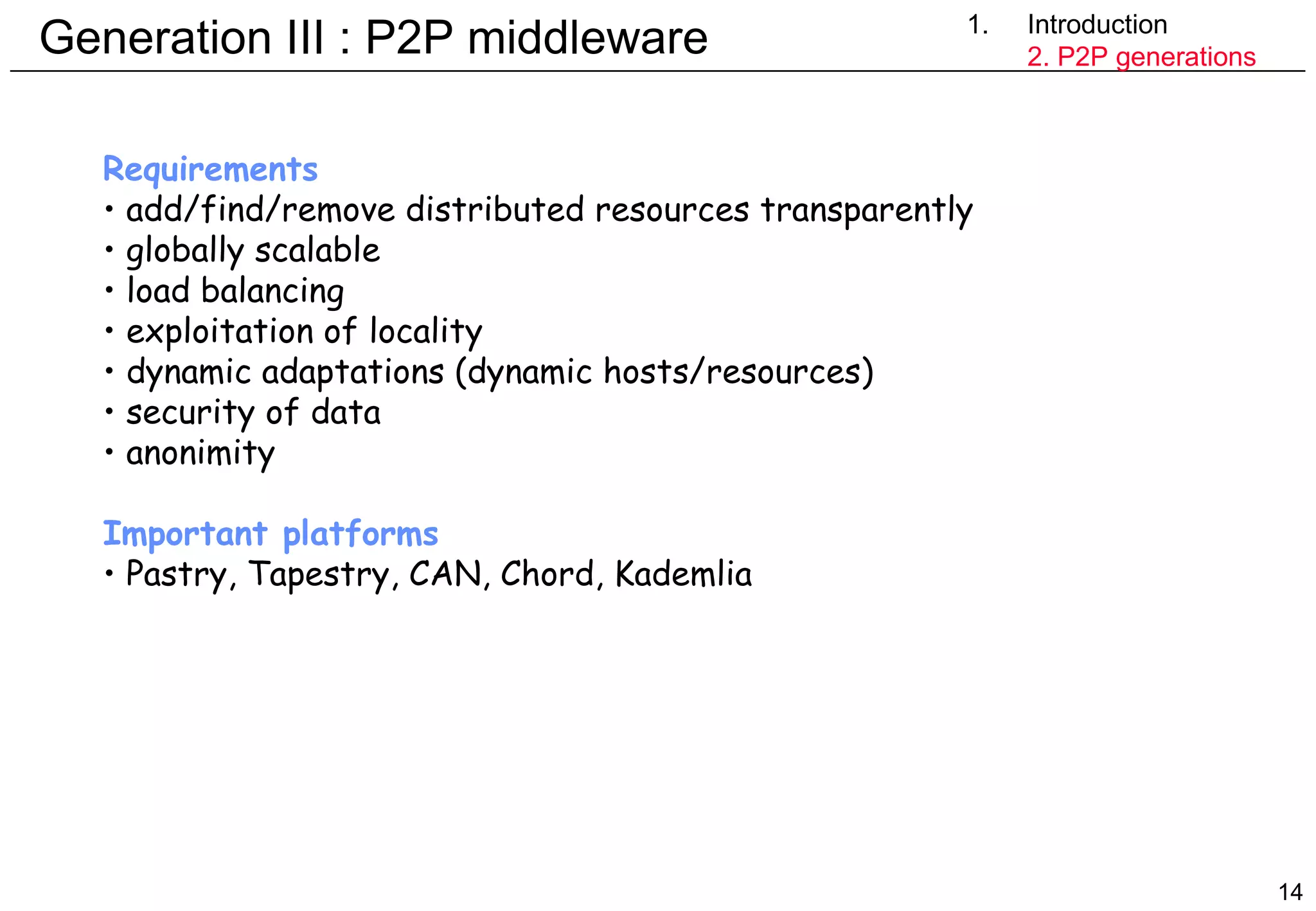
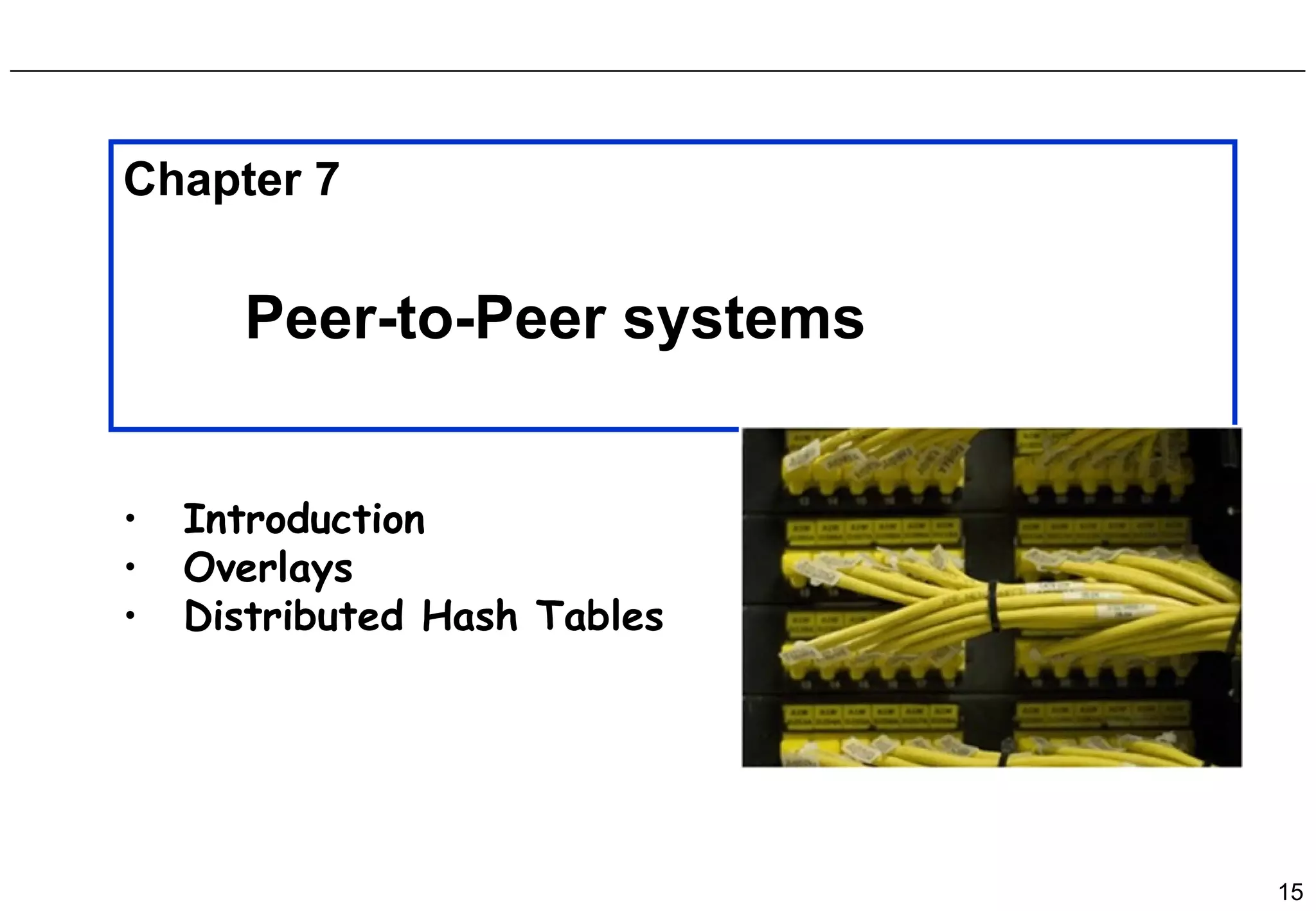


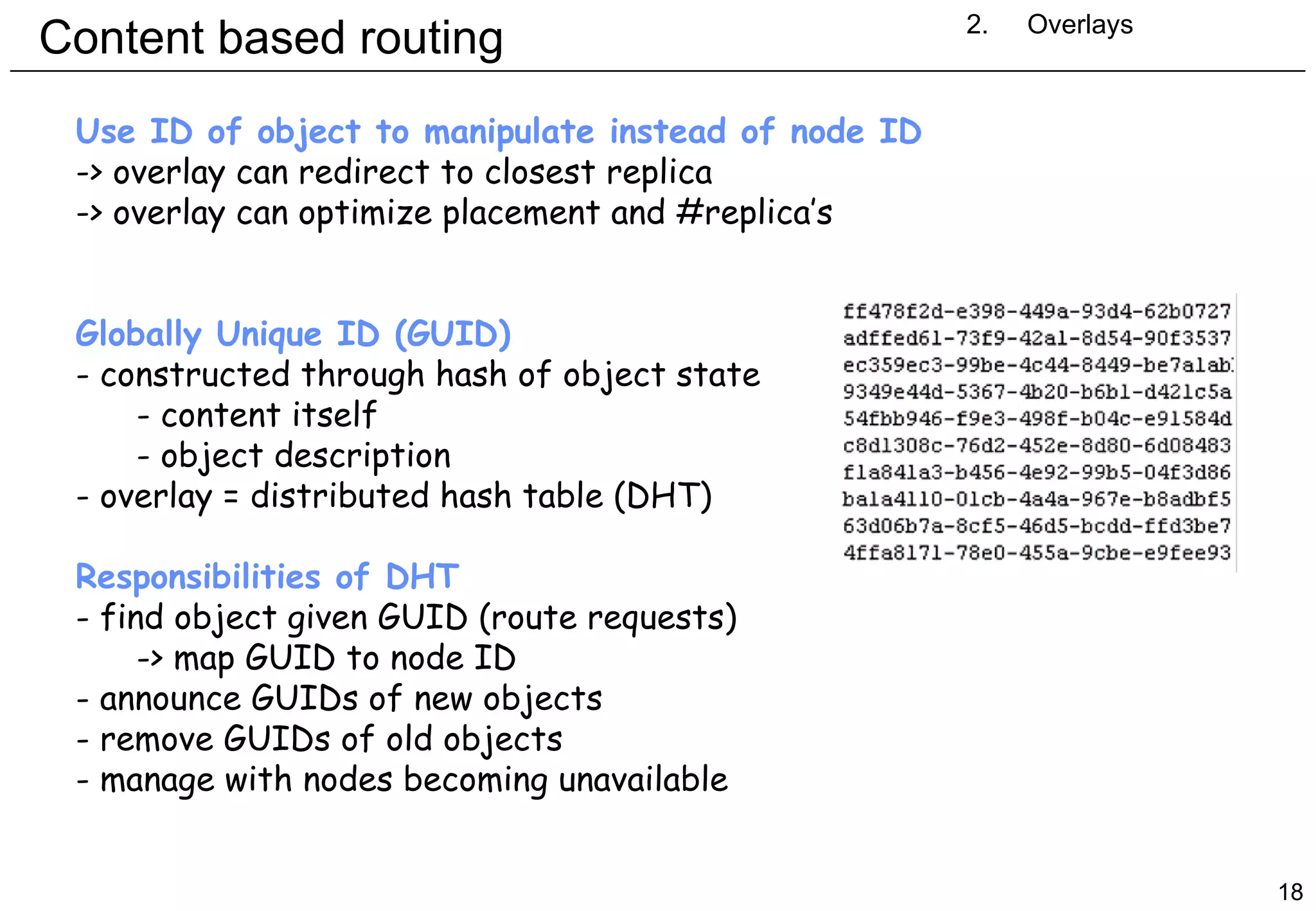
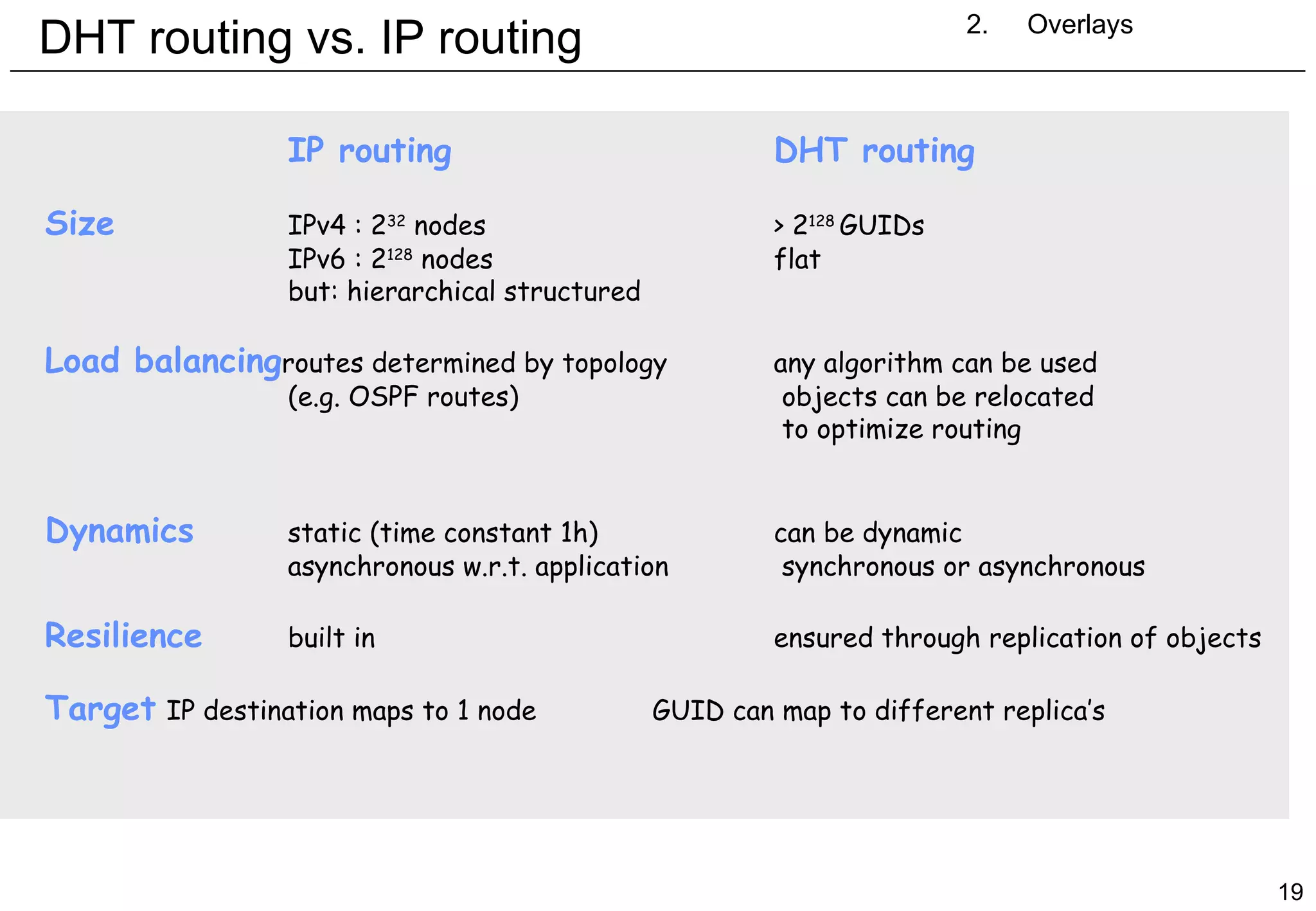
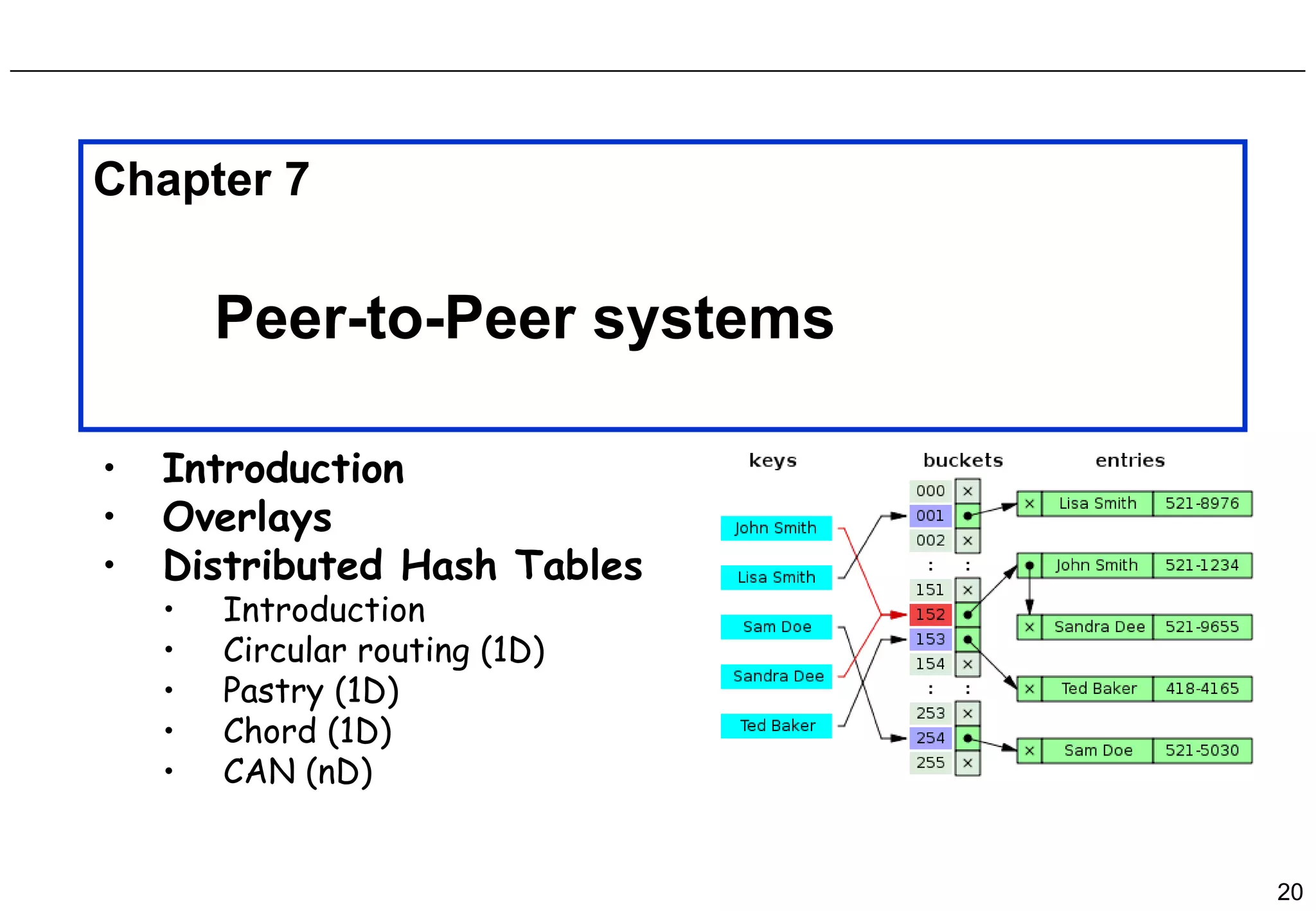
![Data management APIs 3. Distributed Hash Tables 1. Introduction Distributed Hash Table [DHT] API put(GUID,data) remove(GUID) value = get(GUID) DHT takes care of: finding good location number of replicas needed Distributed Object Location and Routing [DOLR] API publish(GUID) unpublish(GUID) sendToObj(message,GUID,[#]) node made explicitely responsible for GUID](https://image.slidesharecdn.com/odschapter7-120122161552-phpapp02/75/Ods-chapter7-21-2048.jpg)
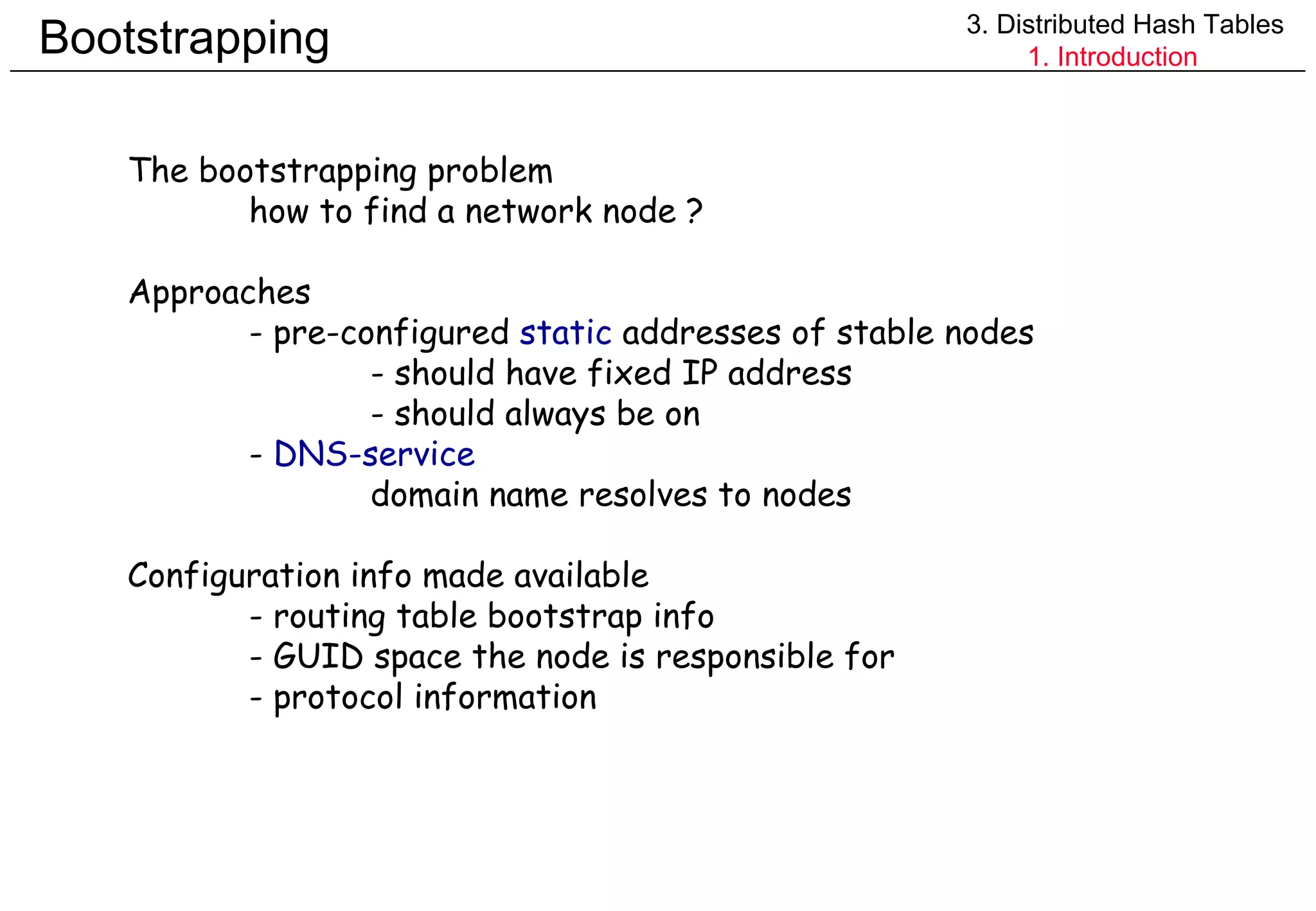
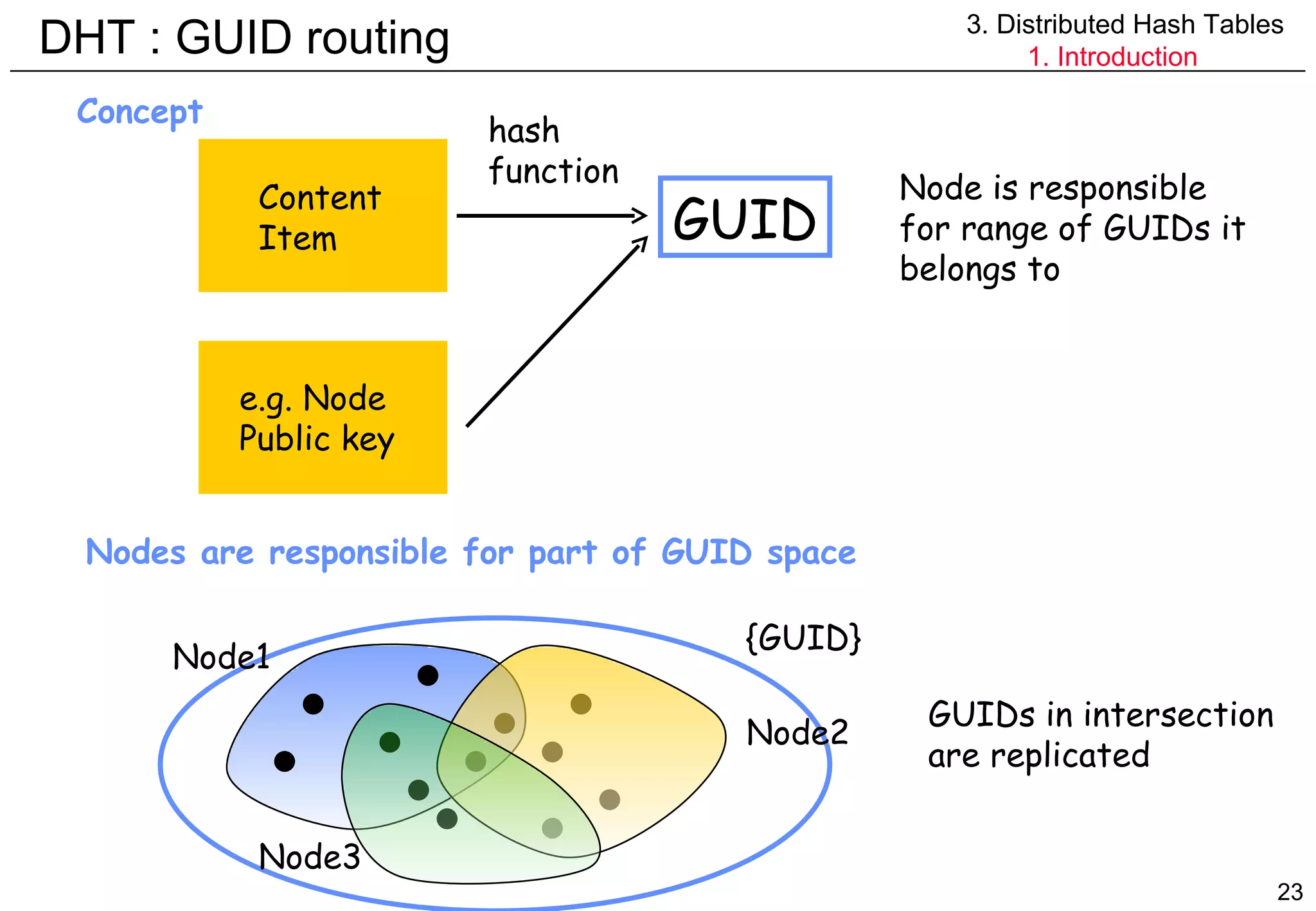
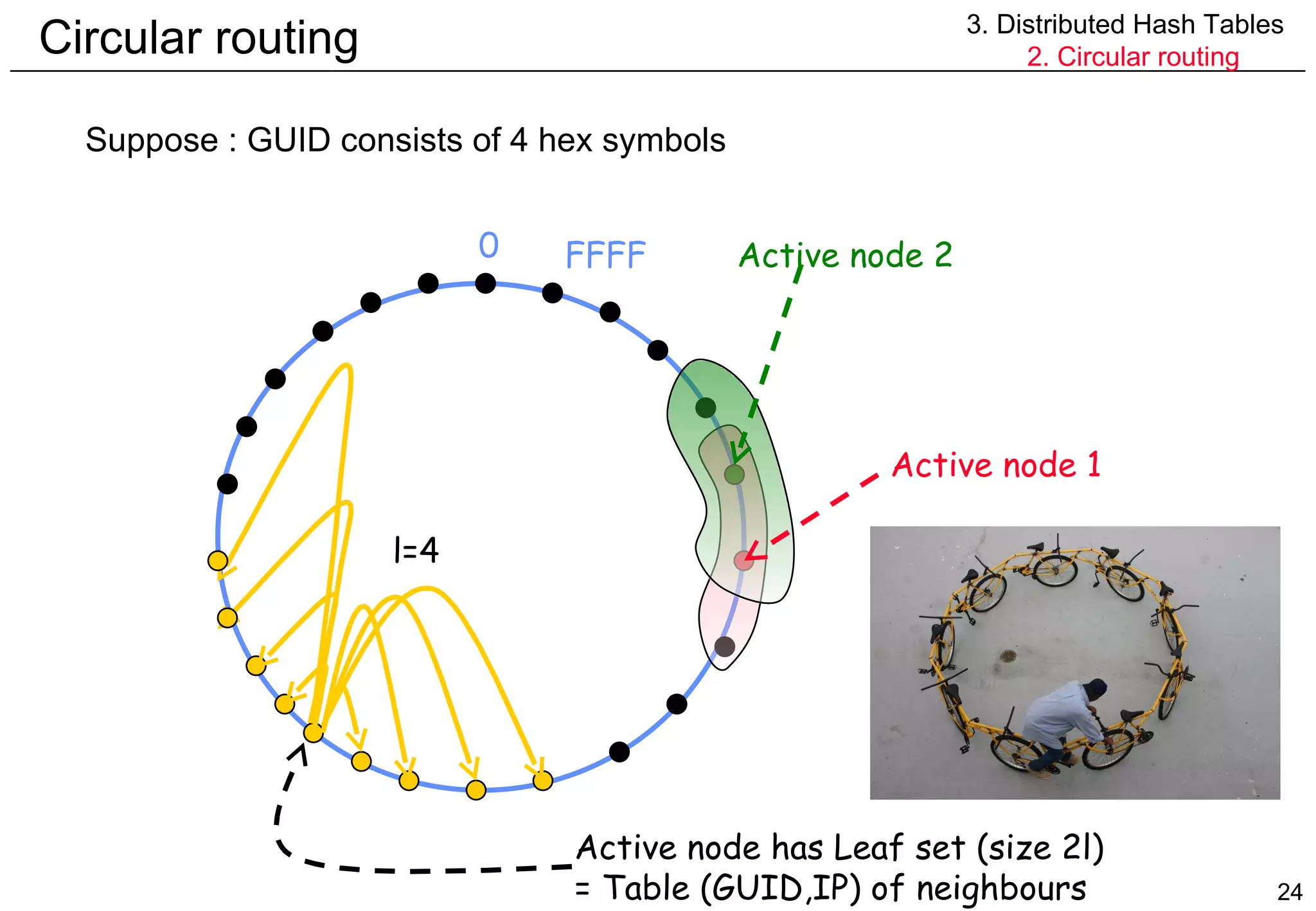
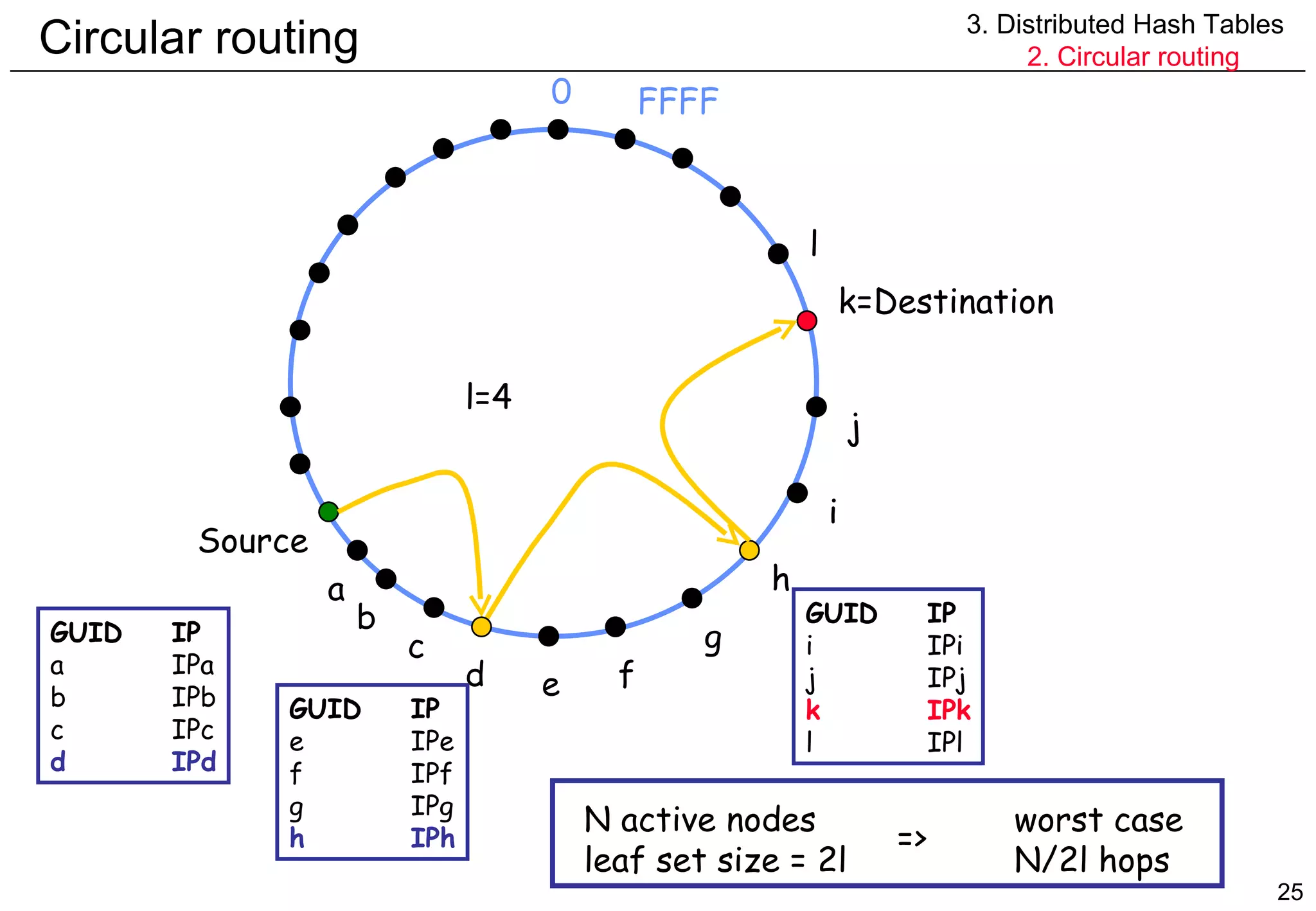
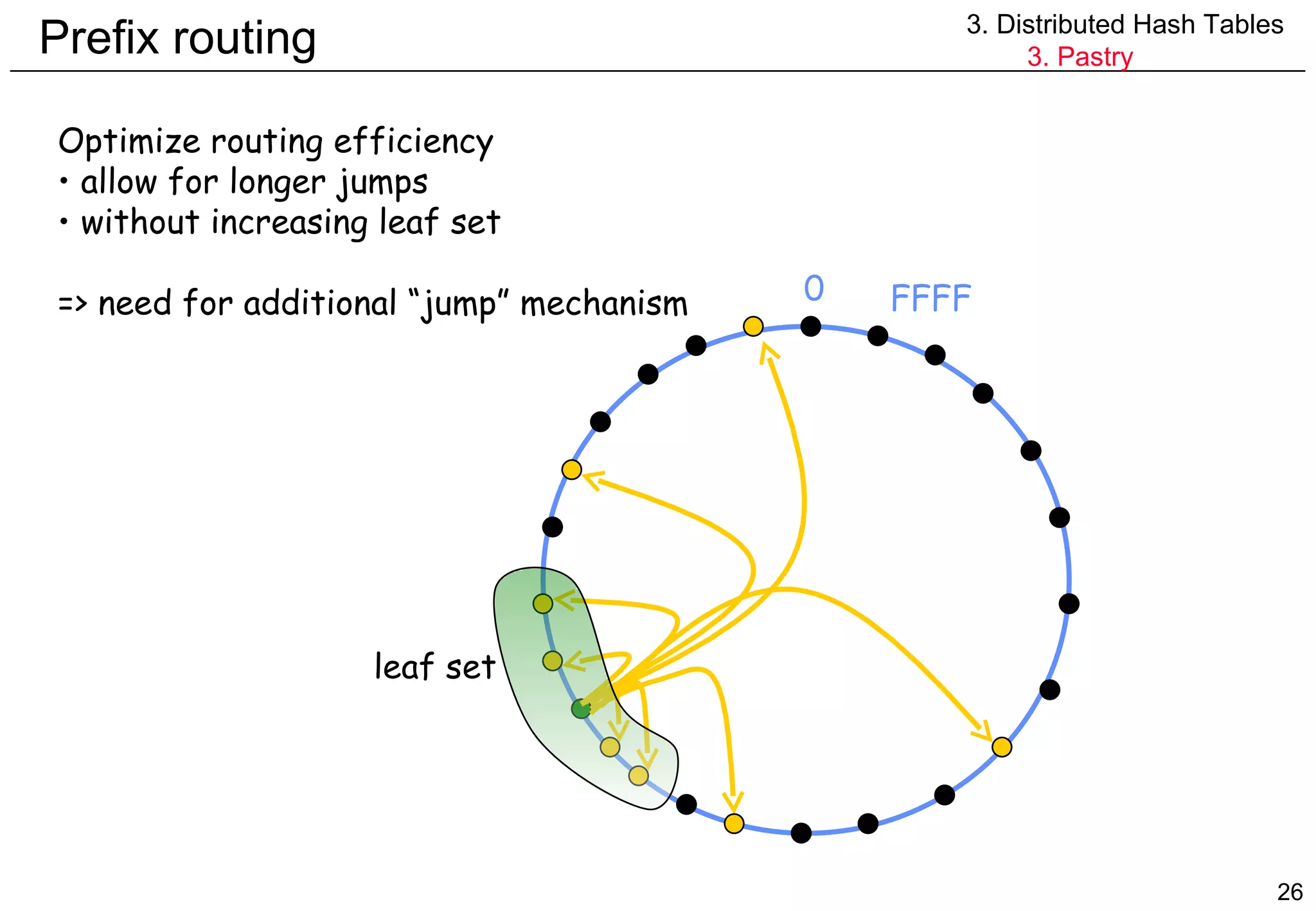
![Prefix routing Routing table structure @active node n-bit GUID -> n/4 routing table rows (16 bit -> 4 rows) p = longest prefix match Routing table of node with GUID 53AF p 0 1 2 3 4 5 6 7 8 9 A B C D E F 0 x x x x x x x x x x x x x x x 1 x x x x x x x x x x x x x x x 2 x x x x x x x x x x x x x x x 3 x x x x x x x x x x x x x x x [GUID,IP] of next hop for message destinated for 53A3 (=closest active node to 53A3) [GUID,IP] of next hop for message destinated for 5Cxx 3. Distributed Hash Tables 3. Pastry](https://image.slidesharecdn.com/odschapter7-120122161552-phpapp02/75/Ods-chapter7-27-2048.jpg)
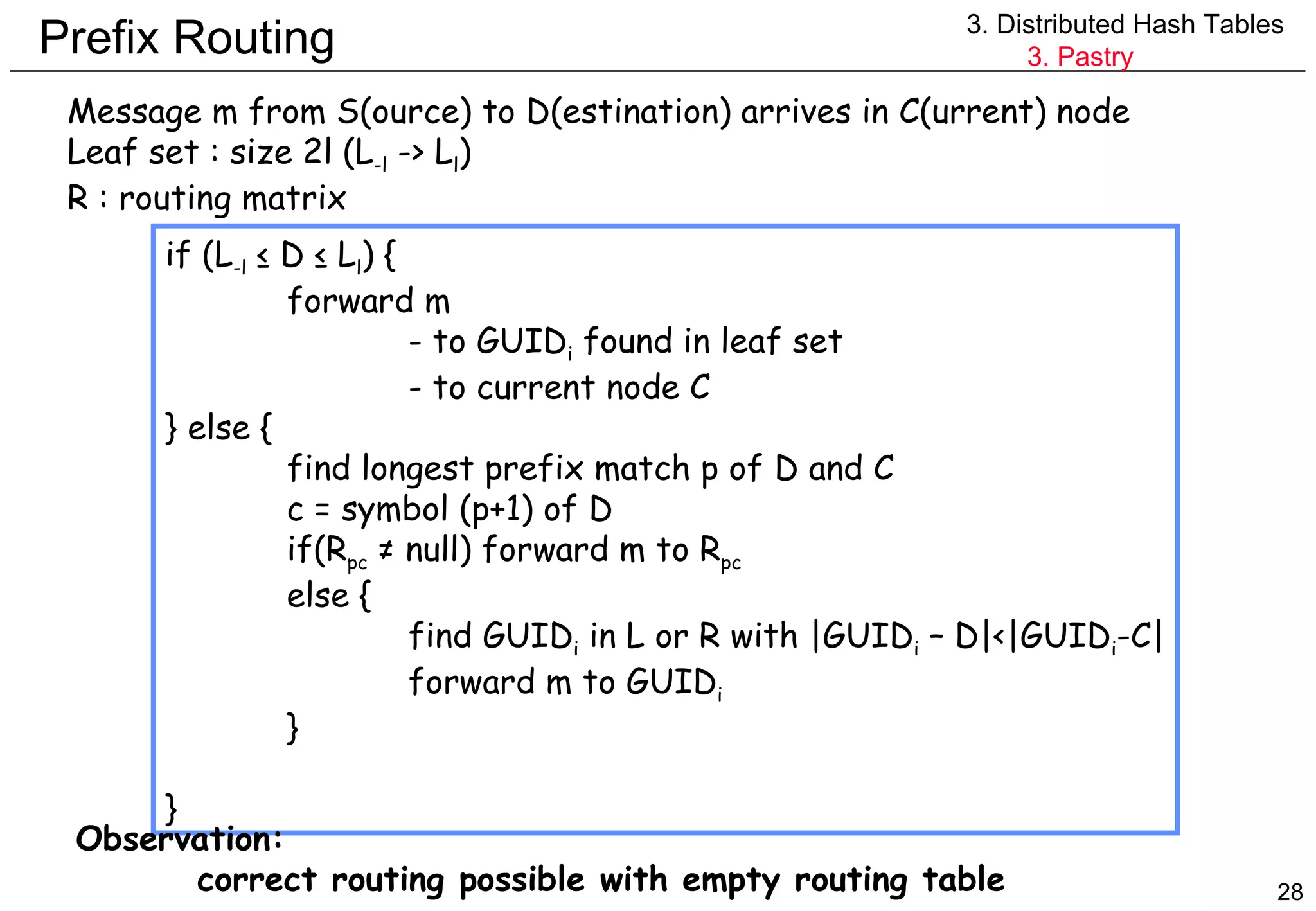

![Node dynamics : Joining Contructing R X {B 0 ,B 1 ,B 2 , ... ,B N-1 } = set of physical nodes visited by Join message B 0 =B B N-1 =F Row 0 : - used to route GUID with no common prefix - bootstrap node B 0 (very) close to X => R X [0]=R B0 [0] Row 1 : - used to route GUID with common prefix 1 - prefix(GUID B1 ,GUID X ) ≥1 => R X [1]=R B1 [1] ... Row i : => R X [i]=R Bi [i] Constructing L X X should be neighbour of F intial choice : L X =L F 3. Distributed Hash Tables 3. Pastry](https://image.slidesharecdn.com/odschapter7-120122161552-phpapp02/75/Ods-chapter7-30-2048.jpg)
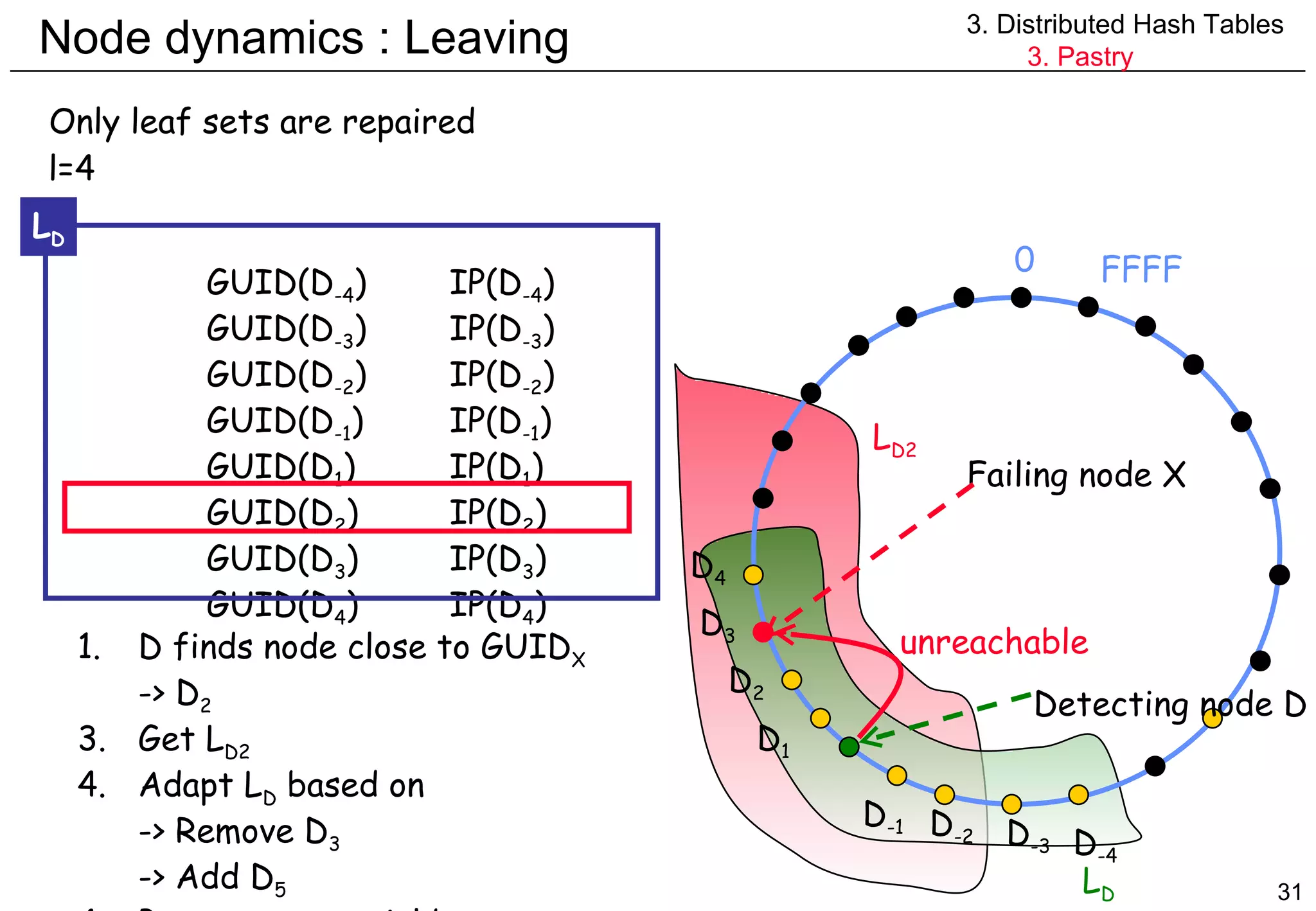
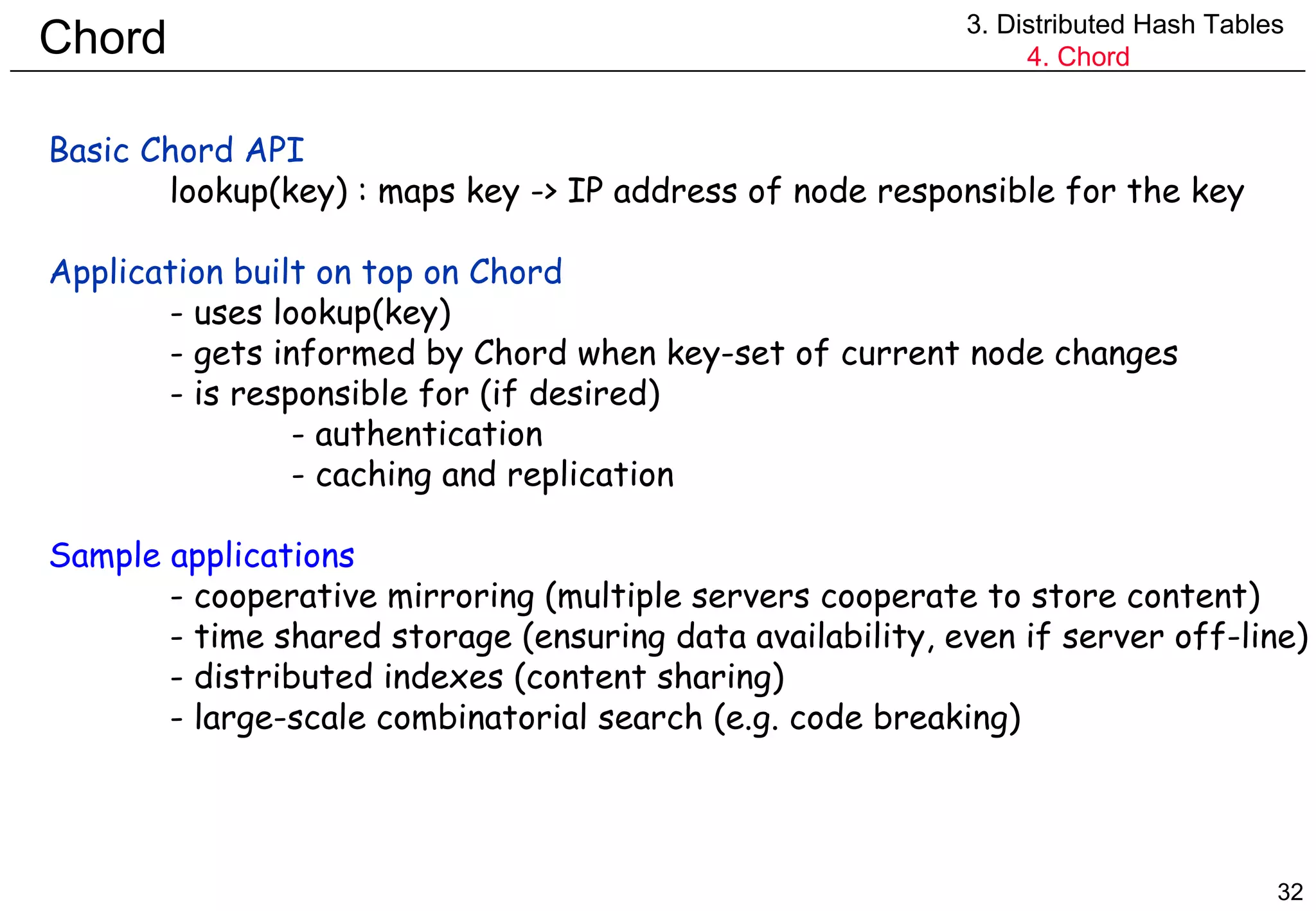
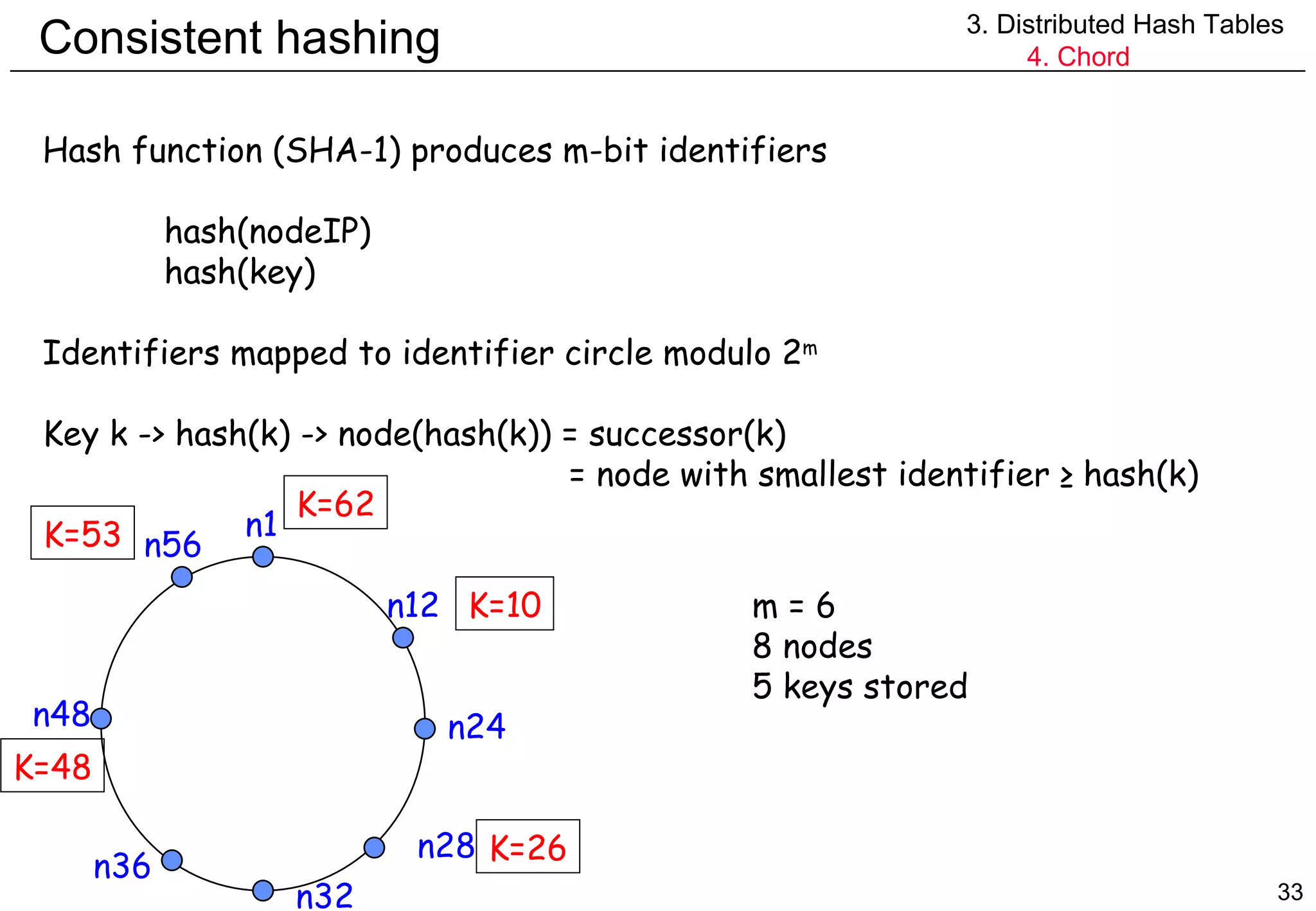
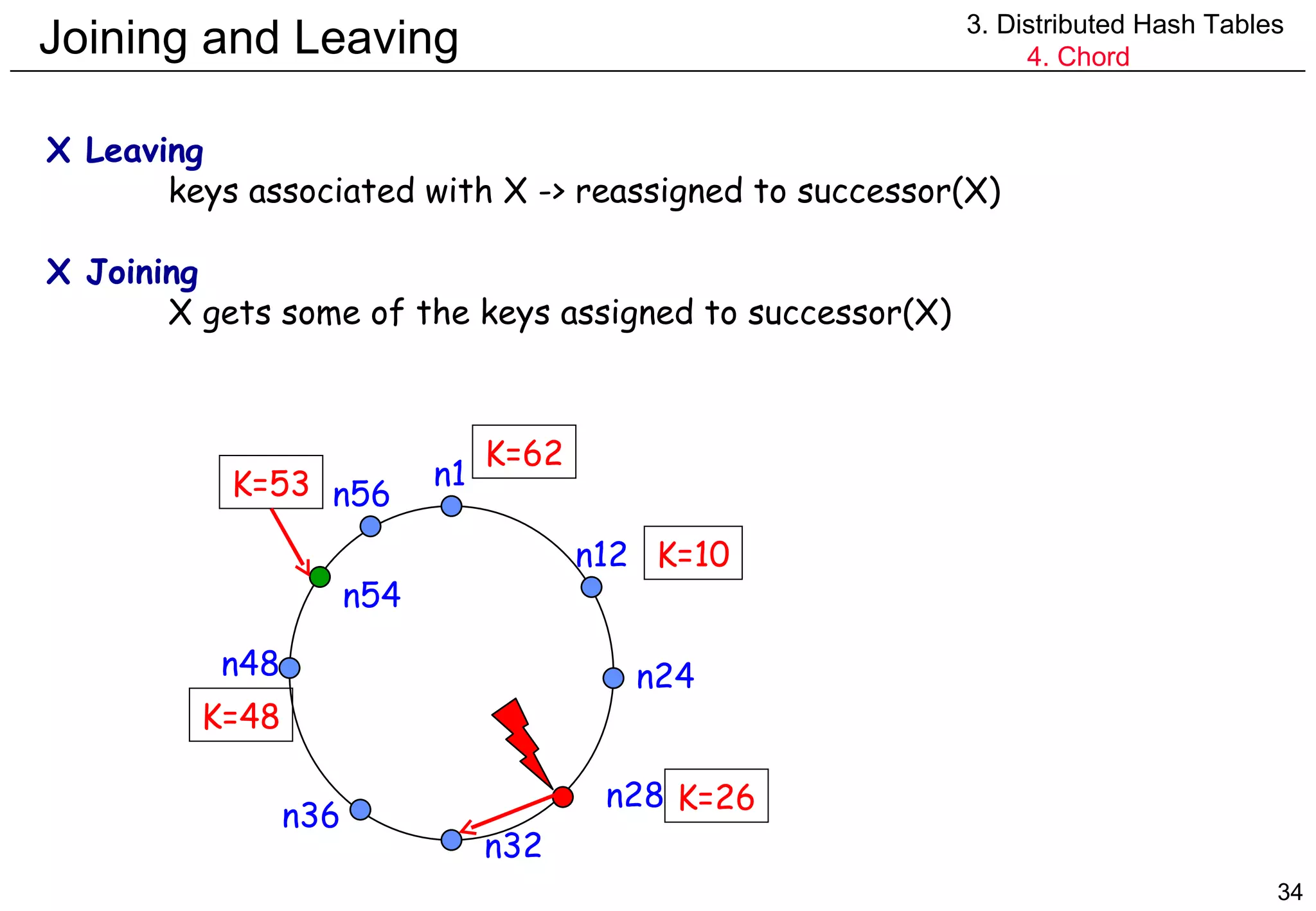
![Simple Routing 3. Distributed Hash Tables 4. Chord Request lookup(id) arrives at node n Node n knows id of its successor n.findSuccessor(id) { if id in (n,successor] return successor else return successor.findSuccessor(id) } n1 n12 n32 n56 n48 n36 n28 n24 lookup(53) K=26 K=48 K=62 K=53 (a,b] Clockwise interval Excluding a, including b](https://image.slidesharecdn.com/odschapter7-120122161552-phpapp02/75/Ods-chapter7-35-2048.jpg)
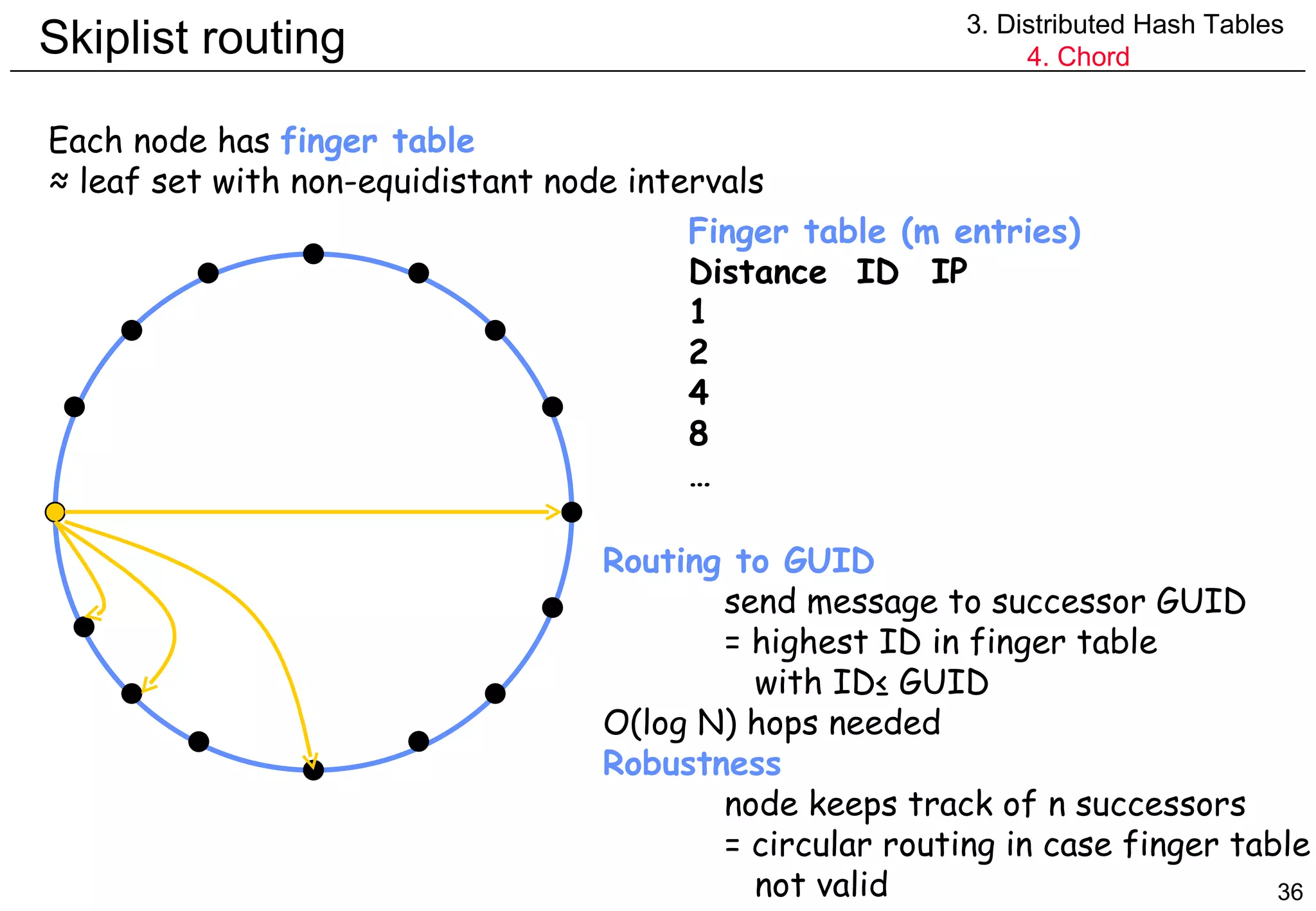
![Skiplist routing 3. Distributed Hash Tables 4. Chord Finger table Distance ID IP 1 2 4 More formally row i in finger table is node at distance larger than 2 i-1 finger[i] =successor(n+2 i-1 ) (i≥1) n1 n12 n32 n56 n48 n36 n28 n24 Finger table (m=6) n12+1 n24 n12+2 n24 n12+4 n24 n12+8 n24 n12+16 n28 n12+32 n48 Finger table (m=6) n48+1 n56 n48+2 n56 n48+4 n56 n48+8 n56 n48+16 n1 n48+32 n24](https://image.slidesharecdn.com/odschapter7-120122161552-phpapp02/75/Ods-chapter7-37-2048.jpg)
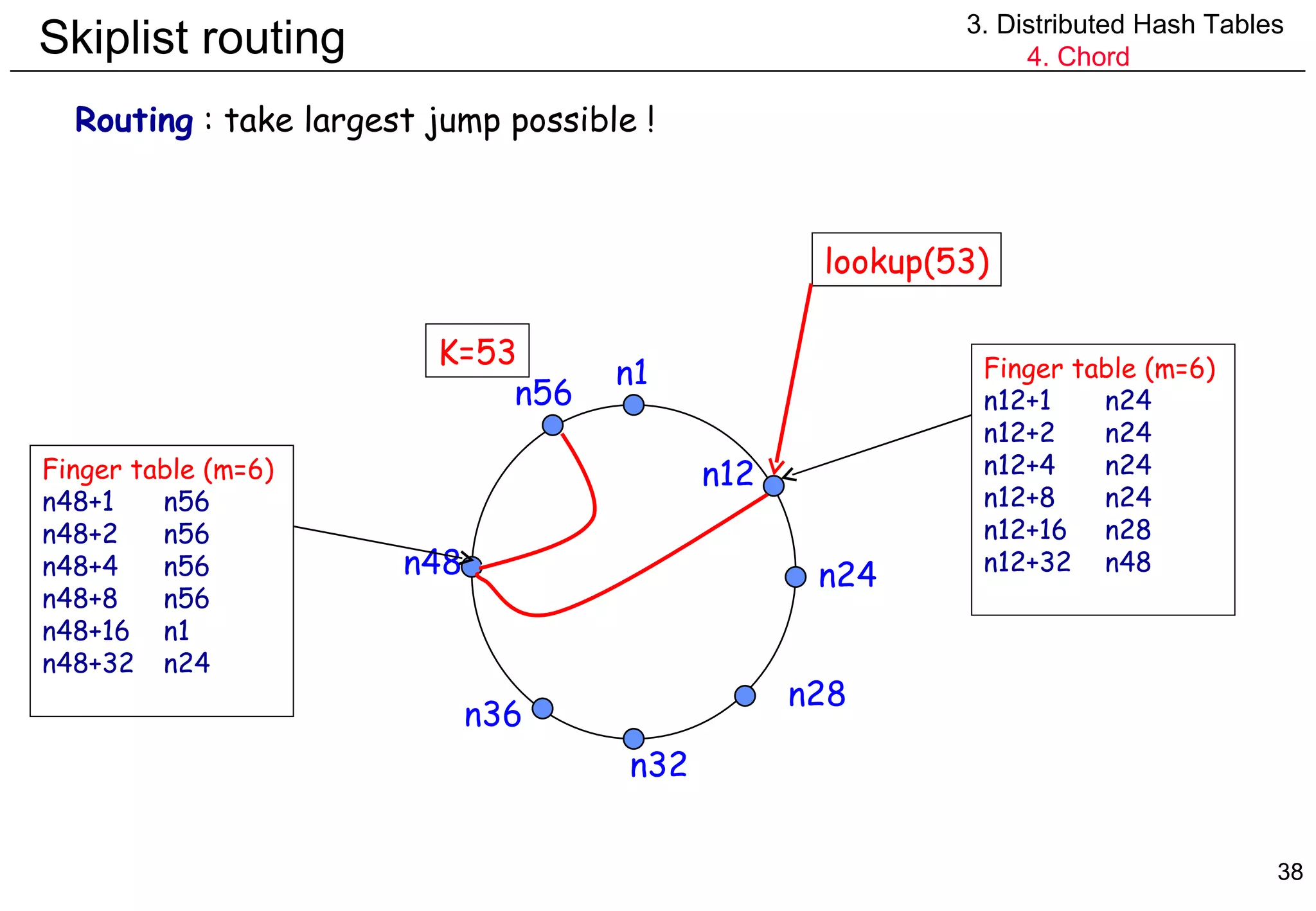
![Skiplist routing 3. Distributed Hash Tables 4. Chord Routing : take largest jump possible ! n.findSuccessor(id) { if id in (n,successor] return successor else { n’=closestPreceedingNode(id) return n’.findSuccessor(id) } } n.closestPreceedingNode(id) { for i=m downto 1 if finger[i] in (n,id] return finger[i] return n }](https://image.slidesharecdn.com/odschapter7-120122161552-phpapp02/75/Ods-chapter7-39-2048.jpg)
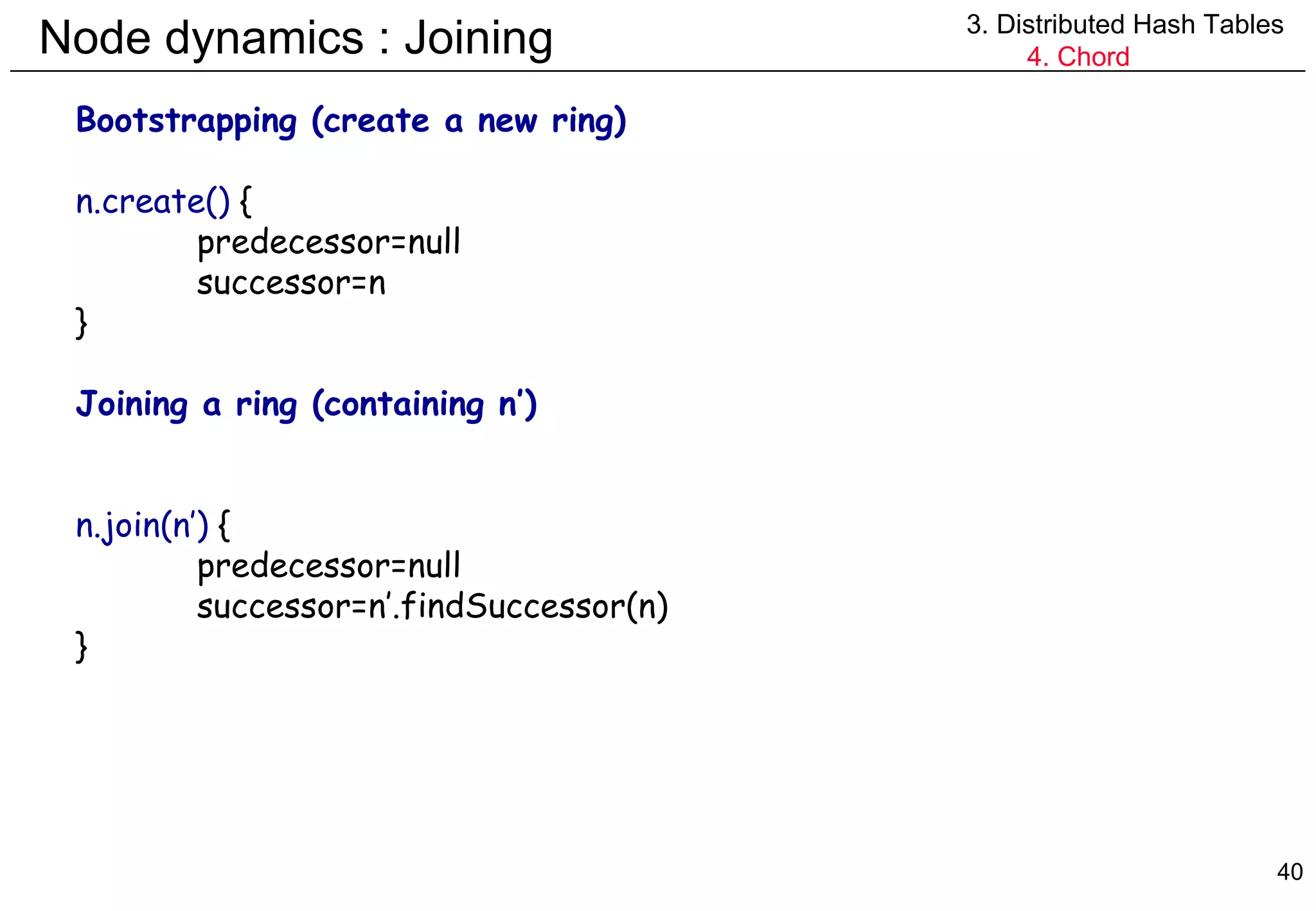
![Node dynamics : Stability 3. Distributed Hash Tables 4. Chord Stabelizing the ring Runs periodically Informs nodes about newly joined nodes Fix finger tables Fix predecossors n.stabilize() { x=successor.predecessor if x in (n,successor] successor = x // better successor found successor.notify(n) // adapt predecessor of successor } n.notify(n’) { //n’ thinks it is the predecessor of n if (predecessor==null) OR (n’ in (predecessor,n[) predecessor = n’ // better predecessor found }](https://image.slidesharecdn.com/odschapter7-120122161552-phpapp02/75/Ods-chapter7-41-2048.jpg)
![Node dynamics : Stability 3. Distributed Hash Tables 4. Chord n.stabilize() { x=successor.predecessor if x in (n,successor] successor = x // better successor found successor.notify(n) // adapt predecessor of successor } n.notify(n’) { //n’ thinks it is the predecessor of n if (predecessor==null) OR (n’ in (predecessor,n[) predecessor = n’ // better predecessor found } Steady-State : no changes ! P.stabilize() - adapts successor @P (s P ) - adapts predecessor @Q (p Q ) If successor and predecessor @P and Q correct, i.e. s P = Q, p Q = P x=successor.predecessor=(s P ).predecessor=p (sP) =p Q =P -> x in (P,Q] ? -> FALSE -> Q.notify(P) P in (p Q ,Q[ ? -> P in (P,Q[ ? -> FALSE NO UPDATES P( s P ,p P ) Q(s Q , p Q )](https://image.slidesharecdn.com/odschapter7-120122161552-phpapp02/75/Ods-chapter7-42-2048.jpg)
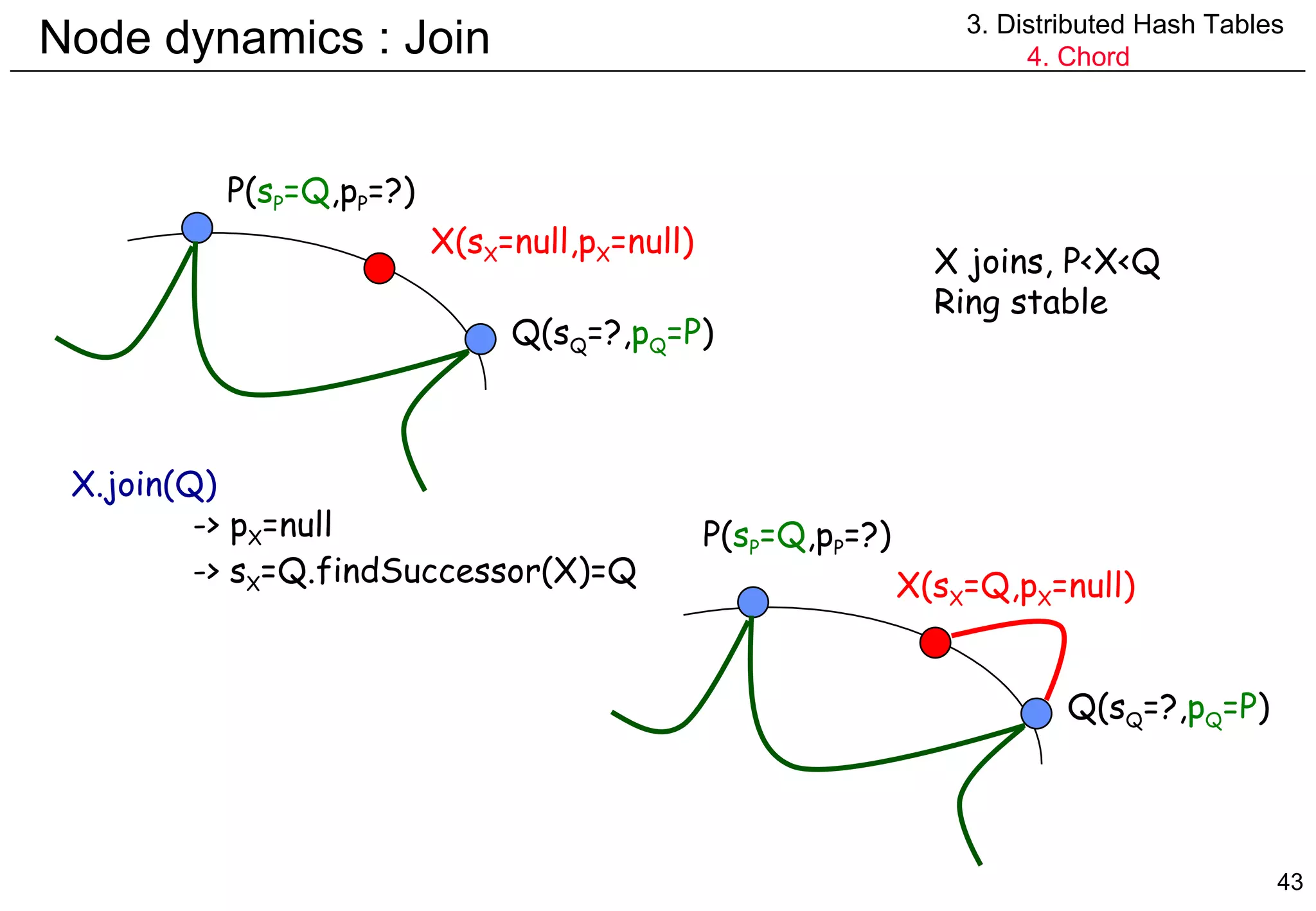
![Node dynamics : Join 3. Distributed Hash Tables 4. Chord X.stabilize() -> x=successor.predecessor=(s X ).predecessor=p (sX) =p Q =P -> P in (X,Q] -> FALSE -> Q.notify(X) Q.notify(X) -> X in (p Q ,Q[ = (P,Q[ -> TRUE -> p Q =X P( s P =Q ,p P =?) Q(s Q =?, p Q =P ) X( s X =Q ,p X =null) P( s P =Q ,p P =?) Q(s Q =?, p Q =X ) X( s X =Q ,p X =null)](https://image.slidesharecdn.com/odschapter7-120122161552-phpapp02/75/Ods-chapter7-44-2048.jpg)
![Node dynamics : Join 3. Distributed Hash Tables 4. Chord P.stabilize() -> x=successor.predecessor=(s P ).predecessor=p (sP) =p Q =X -> X in (P,Q] -> TRUE -> s P =X -> X.notify(P) X.notify(P) -> p X == null -> p X =P P( s P =Q ,p P =?) Q(s Q =?, p Q =X ) X( s X =Q ,p X =null) P( s P =X ,p P =?) Q(s Q =?, p Q =X ) X( s X =Q , p X =P )](https://image.slidesharecdn.com/odschapter7-120122161552-phpapp02/75/Ods-chapter7-45-2048.jpg)
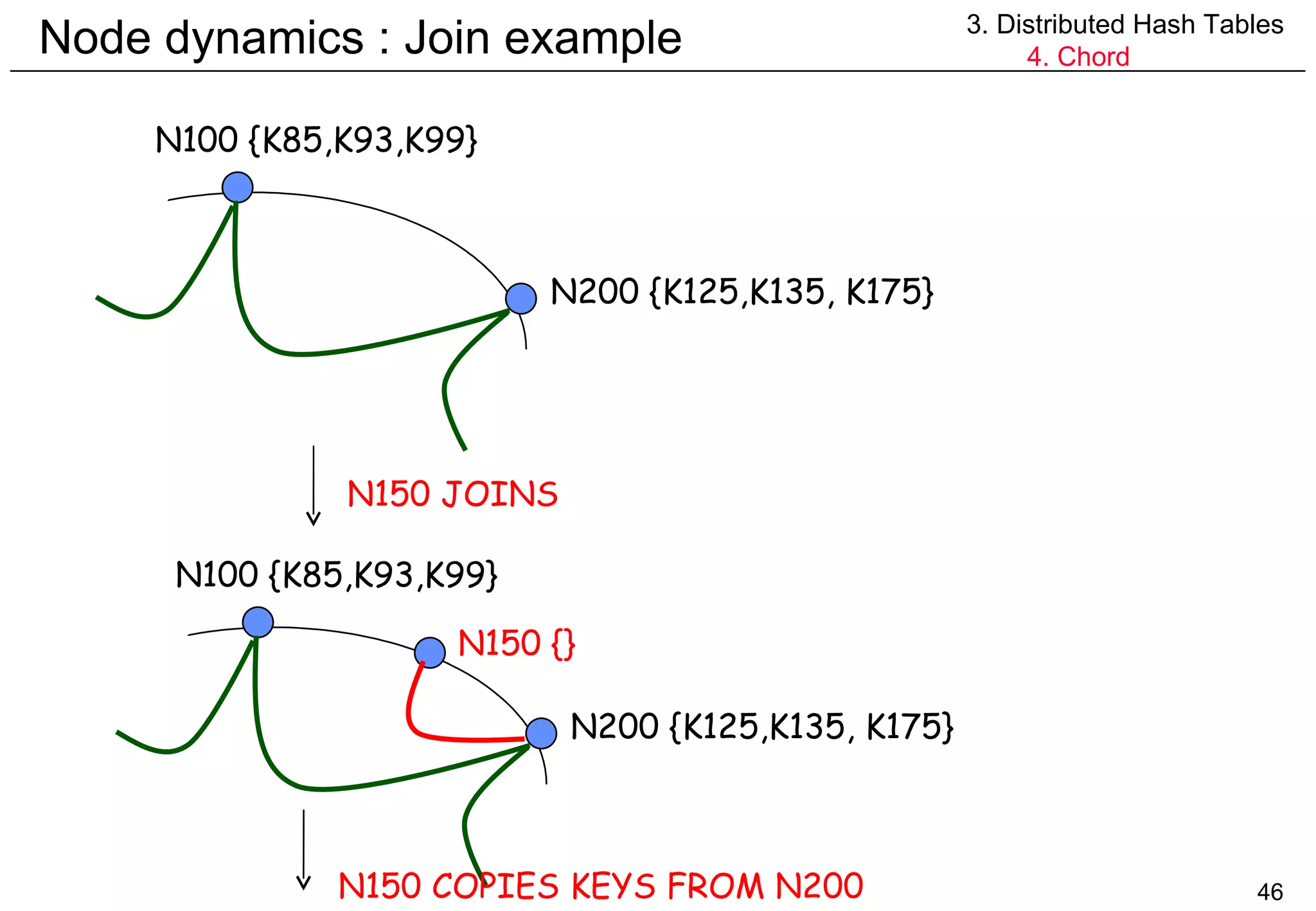

![Node dynamics : Stability 3. Distributed Hash Tables 4. Chord n.fixFingers() { next++ // f[next] will be fixed if (next>m) next = 1 finger[next]=findSuccessor(n+2 next-1 ) } n.checkPredecessors() { // allows active predecessor to enter if (predecessor failed) predecessor = null }](https://image.slidesharecdn.com/odschapter7-120122161552-phpapp02/75/Ods-chapter7-48-2048.jpg)
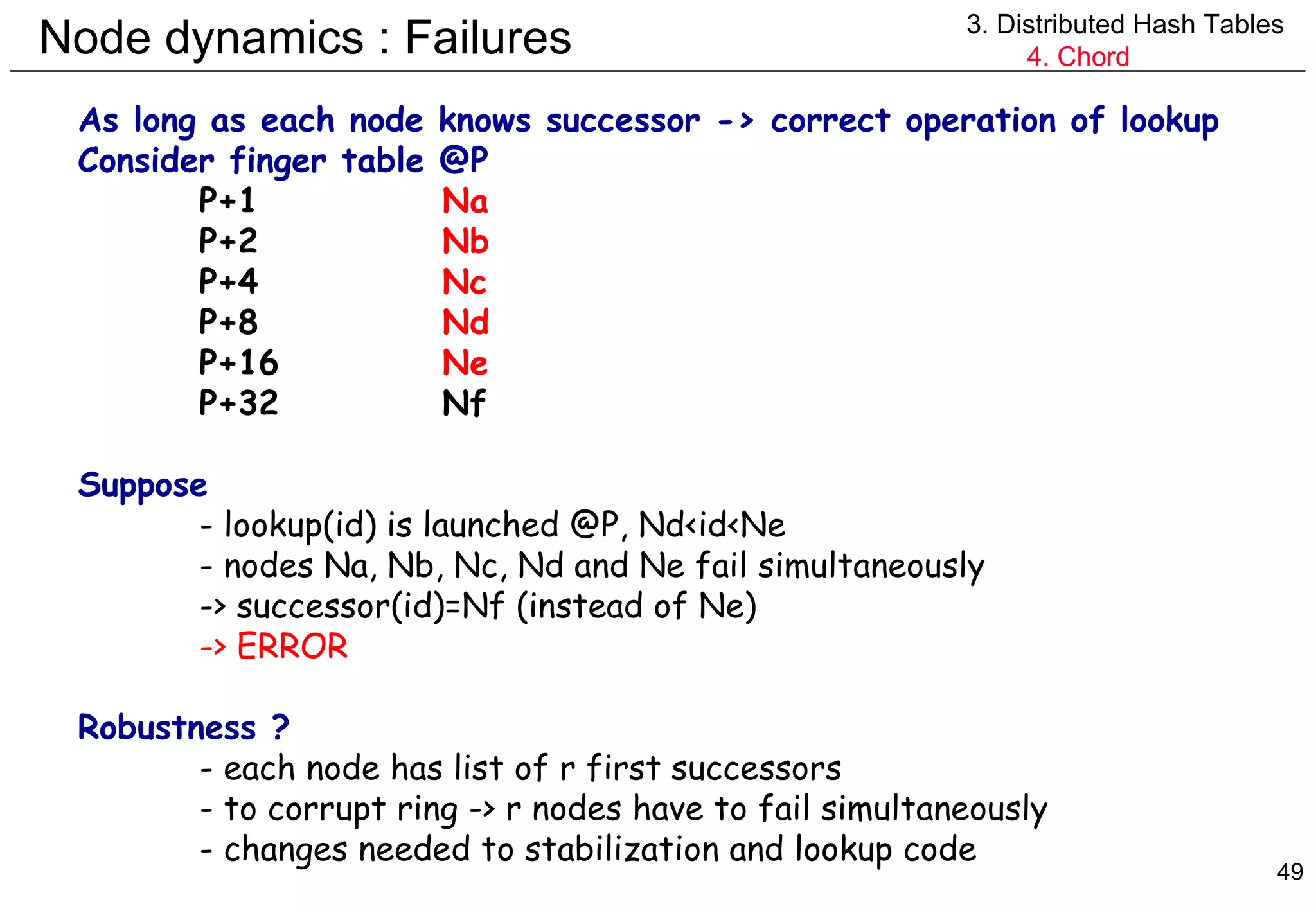
![Node dynamics : Failures (pseudo code) 3. Distributed Hash Tables 4. Chord n.findSuccessor(id) { if id in (n,successor] return successor else { try { n’=closestPreceedingNode(id) return n’.findSuccessor(id) } catch(TimeoutException e) { invalidate n’ from finger and successor table return n.findSuccessor(id) } } } n.closestPreceedingNode(id) { for i=m downto 1 if finger[i] in (n,id] return finger[i] for i=r downto 1 if successor[i] in (n,id] return successor[i] return n }](https://image.slidesharecdn.com/odschapter7-120122161552-phpapp02/75/Ods-chapter7-50-2048.jpg)
![Multi-dimensional routing 3. Distributed Hash Tables 5. CAN CAN : Content addressable network Basic idea use d-dimensional space to map keys node is responsible for d-dimensional hypercube - Cartesian coordinates used - space is d-torus Example 2D (1,0) (0,0) (0,1) (1,1) [0.0->0.5,0.5->1.0] [0.0->0.5,0.0->0.5] [0.5->1.0,0.5->1.0] [0.5->0.75, 0.25->0.5] [0.5->0.75, 0.0->0.25] [0.75->1.0, 0.0->0.5]](https://image.slidesharecdn.com/odschapter7-120122161552-phpapp02/75/Ods-chapter7-51-2048.jpg)
